|
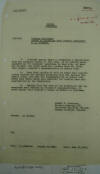
|
1. June 17, 1930.
G-2 Translation of article in
El Dictamen, Veracruz,
May 30, 1930, letter from Dr.
Pedro José Zepeda, Mexico City,
Capt. Robert E. Cummings, Acting
Military Attaché, p. 1.
"G-2 Report ¶ 3850-a ¶ MEXICO ¶
POLITICAL ¶ SUBJECT: Foreign
Relations: ¶ Status of Relations
with Foreign Countries: ¶ C. A.
SANDINO. ¶ 1. Attached hereto
there is forwarded a
translation, from the American
Consul at Vera Cruz, of an
article which appeared in “El
Dictamen” published in that
city, of date May 30, 1930, and
which contains a letter from Dr.
Pedro José Zepeda, Sandino’s
representative in Mexico City. ¶
2. From this article it will be
noted that Augusto Caesar
Sandino has severed relations
with the Mexican Communist
Party, and that his
representative in Mexico City
hints that funds which were
destined for Sandino were
misappropriated by the
Communists. ¶ 3. Judging from
the tone of the letter, and the
accusations made therein by
Sandino’s representative, it
would appear that Sandino’s
career in Mexico is finished. ¶
Robert E. Cummings, ¶ Captain,
Infantry, DOL, ¶ Assistant
Military Attaché, ¶ Acting
Military Attaché. ¶ Source: At
stated. ¶ C/p ¶ From:
M.A.Mexico. ¶ Report No. 2948. ¶
Date: June 17, 1930. . . . "
|
|
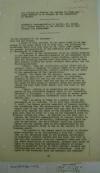
|
2. June 17, 1930.
G-2 Translation of article in
El Dictamen, Veracruz,
May 30, 1930, letter from Dr.
Pedro José Zepeda, Mexico City,
Capt. Robert E. Cummings, Acting
Military Attaché, p. 2.
"
. . . The Attacks on Sandino are
because he would not allow
himself to be managed by the
Communists in Mexico. ¶
Sandino’s representative in
Mexico, Dr. Zepeda, in a letter
replies to the attacks, and in
turn accuses the Communists. ¶
“To the Director of “El
Dictamen”: ¶ Dear Sir and
Friend: ¶ I would be very
grateful if you would cause to
be published in the paper which
you so ably edit, the following
declarations which have been
made by Dr. Pedro José Zepeda,
the general representative of
the defending army of the
National Sovereignty of
Nicaragua: ¶ “By reason of the
accusations which Sr. Hernán
Laborde, in his position of
secretary-general of the
Communist party, made against
General Augusto Caesar Sandino,
permit me to make the following
explanations from which it can
be seen that General Sandino has
never betrayed that party, for
the following reasons: ¶ “First:
When the Association called
‘Hands off Nicaragua’ began a
campaign to collect funds to be
delivered to the Nicaraguan
patriots, General Sandino was
not aware of the connections of
that association. ¶ “Second: The
funds for the purpose, which
were turned over to the army
which I have the honor to
represent, amounted to $250.00;
and all the world knows that
this amount would not serve even
for one day to take care of the
needs of that group of patriots
which has maintained itself for
more than three years, with the
rifle at the shoulder. ¶ “Third:
Having in my possession the
complete archives of the
invincible supreme chief of the
Liberation Movement of
Nicaragua, I am in a position to
answer point by point, the
calumnious statements which may
be made against him. ¶ “Now I am
going to reply in a general way,
to the statements of Sr.
Laborde. It is true that
Constantino F. Martí, the former
private secretary of General
Sandino, was discharged from the
headquarters of that chief, for
the reason that it had been
proved that not only did ne not
serve with loyalty the cause of
the defenders of Nicaragua, but
also that he acted as a spy of
the Communist Party in Mexico,
within our army. In addition to
the fact that I possess the
official communications of
General Sandino in which he
advised me officially,
indicating that said notice be
published, the said Colonel
Martí has declared before
various persons that he was
commissioned by the aforesaid
Communist Party to spy on the
actions of our supreme chief. ¶
“In respect to the second point
in which Sr. Laborde makes
reference to my declarations, I
said and I repeat, that in the
defending army of the national
sovereignty of Nicaragua,
General Sandino did not have,
nor does he now have, any
agreement with the Communist
Party nor with any other
association or government,
because this would be equal to
taking away the undisputed
liberty of action which is
necessary for us to carry
forward, without any
interruption, our plan of
National liberation. With
respect to the statement that
our movement has betrayed . . .
"
|
|
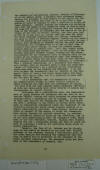
|
3. June 17, 1930.
G-2 Translation of article in
El Dictamen, Veracruz,
May 30, 1930, letter from Dr.
Pedro José Zepeda, Mexico City,
Capt. Robert E. Cummings, Acting
Military Attaché, p. 3.
" . . . the working and
agricultural classes, whether of
Nicaragua or of the entire
world, I consider such statement
absurd, because our struggle in
this moment is not social but
for autonomy, and during such
time as we do not have a free
nation, it would be useless to
take a position in either of
these subjects. General Sandino
has reasons for believing that
from the busom of the Communist
Party of Mexico, there had been
put out the calumnious version
that the interruption of the
struggle in Nicaragua, was the
result of the betrayal of our
army by General Sandino, and
they even went so far as to say
that Dr. Carlos León had seen
the check for sixty thousand
dollars which the Mexican
Government had sent in order to
convince General Sandino of the
necessity for giving up the
struggle. As may naturally be
suspected, this produced in
General Sandino the most violent
indignation, but incapacitated
as he was at that time to
disprove this grave charge, he
took the prudent course, leaving
them, as he himself said, “that
they should clean up the filth
they had thrown”. This is the
origin of the letters exchanged
between General Sandino and the
secretary-general of the
Communist Party of Mexico; this
is the origin of the sarcastic
declaration that ‘the Communist
Party of Mexico being the one
from which we have received most
help, in our anti-Imperialistic
struggle in Nicaragua’. This I
likewise underlined, as I
underline that which I said
before, that we received $250.00
from the committee ‘Hands Off
Nicaragua’, as a product of the
collections which were made in
the streets and theaters. I do
not care to make the accusation
that Sr. Laborde or the
Communist Party of Mexico had
taken these funds, but they,
better than anyone else, are in
a position to know what use was
made of them. ¶ “It is
undeniable that the Communists
of Mexico did unmentionable
things to cause General Sandino
to break relations not only with
the Government of Mexico, but
also with all that element which
sincerely affiliated with our
cause, could have given liberty
of action and independence to
General Sandino. ¶ “Following
out a preconceived plan, the
unpleasantness of Martí towards
the newspaper men who came to
interview General Sandino and
which provoked an unfortunate
incident which I personally had
to arrange. It was due to this
same plan of the Communists that
the same Martí was made a
prisoner as the result of having
given utterance to displeasing
statements about the President
of the Republic; utterances
which placed General Sandino in
a highly embarrassing position.
When General Sandino was given
an account of the manner in
which the Communists were acting
through his private secretary,
he resolved in a determined
manner to clear up the
situation, and it is for this,
fundamentally, that the
Communist Party feels that it
has been betrayed, because,
finding that General Sandino was
not a manageable person and that
he could not have in Nicaragua a
motive for agitation which could
be called Communistic. ¶
“However, the fury of Sr.
Laborde can be clearly seen, in
that, while he assured on one
side that Sandino returned to
the struggle obeying a
utilitarian plan, on the other
hand, he was assuring the
Communists that his stay in
Mexico was in obedience to his
purchase by the North American
Imperialism, the purchase which
had been made by the Government
of Moncada, etc. . . . "
|
|
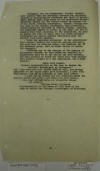
|
4. June 17, 1930.
G-2 Translation of article in
El Dictamen, Veracruz,
May 30, 1930, letter from Dr.
Pedro José Zepeda, Mexico City,
Capt. Robert E. Cummings, Acting
Military Attaché, p. 4.
" . . . Resuming, for the
Communists, General Sandino sold
himself when for strategic
reasons and political reasons,
he provisionally abandoned the
field of battle, where during
three long years he had
maintained himself immovable
before all the united forces of
Moncada and of the North
American Government. General
Sandino was not sold to the
Mexican Government; when
materially incapacitated, he
remained in Mérida, Yucatán,
awaiting the opportune moment to
return to his duty; and now it
results also that according to
the communists, he goes to
gamble his life in order that
the North American Government
may secure greater advantages
from the traitor José María
Moncada. ¶ “Like the pervious
calumnies, is the observation
that General Sandino had
received certain materials, and
even that he received money, the
fabulous sum of two thousand
pesos, that he might return to
resume the struggle. ¶ “Whatever
may be the charges of the
enemies of Nicaraguan liberty,
we find ourselves resolved to
demonstrate that we do not
follow any base motives, and
that earlier or later, the world
will take account that General
Sandino is a man immaculate, and
a true apostle. ¶ Pedro José
Zepeda. ¶ General Representative
of the Army to defend the
National Sovereignty of
Nicaragua.” ¶ And I beg that you
will kindly publish this, for,
having published in the organ
under your direction, a news
item from Mexico City, which
referred to this same affair. ¶
I send you my thanks for the
attention which the present
letter may merit, and remain at
your orders, ¶ Your most
affectionate and attentive
friend ¶ and servant, ¶ Enrique
Rivera Bertrand, ¶
Representative in the State of
Vera Cruz of the Army to defent
[defend] the National
Sovereignty of Nicaragua."
|
|
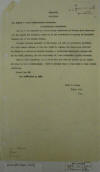
|
5. June 6, 1930.
G-2 Report on Armed
Revolutionary Movements:
Revolutionary Activities, Major
Fred T. Cruse, Military Attaché,
San José.
"NICARAGUA
¶ POLITICAL ¶ No. 3020-d – Armed
Revolutionary Movements. ¶
Revolutionary Activities. ¶ As
was to be expected the recent
heavy withdrawal of Marines from
Nicaragua was the signal for
immediate increase in the
activities of enemies of
President Moncada and of the
United States. ¶ Sandino
returned promptly to Nicaragua,
but with no particular prestige.
Mr. Elio Hazera informs me that
Dr. Pedro J. Zepeda, the
Nicaraguan agitator in Mexico
has written to Gonzalo Navarro,
a well-known Nicaraguan refugee
now in San José, offering him
the leadership of a new
revolution against Moncada. ¶
This is most important, as it
shows that the name of Sandino
is no longer of value to the
revolutionists. Further details
will be forwarded as they become
available. ¶ Report No. 749 ¶
San José--June 6, 1930 ¶ Fred T.
Cruse, ¶ Major, G.S. ¶ M.A."
|
|
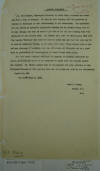
|
6. June 5, 1930.
G-2 Report on Sandino Situation,
Major Fred T. Cruse, Military
Attaché, San José.
"SANDINO
SITUATION ¶ Mr. Elio Hazera,
Nicaraguan Minister to Costa
Rica, returned two weeks ago
from a trip to Managua. He told
me this morning that the
presence of Sandino in Nicaragua
is most embarrassing to the
Government. The officials are
not afraid of extensive
propaganda arising nor of
Sandino being able to do much
damage, but they do want to get
rid of him and are finding this
very difficult at the present
time. Mr. Hazera says that the
Nicaraguans feel that the
Guardia Nacional will never be
able to catch him and that the
only way is to send in volunteer
forces, as was done last year.
These forces made an excellent
clean-up of banditry, but were
of course all Liberals and so a
good deal of persecution of
Conservatives by these forces
took place. ¶ For this reason
General MacDougal is opposed to
sending volunteers in again,
particularly as he is not
prepared to admit that the
Guardia cannot get Sandino. Mr.
Hazera states that in his
opinion the only solution is for
President Moncada to take
matters into his own hands and
send in the volunteers. ¶ Report
No. 746 ¶ San José--June 5,
1930. ¶ Fred T. Cruse, ¶ Major,
G.S. ¶ M.A."
|
|
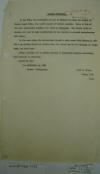
|
7. June 4, 1930.
G-2 Report on Sandino Situation,
Major Fred T. Cruse, Military
Attaché, San José.
"On May 20th, the Government
brought to Managua by plane the
family of Miguel Angel Ortez,
the bandit leader of Western
Segovia. Ortez is one of
the most destructive bandits
ever known in Nicaragua.
His family lived in Ocotal, but
will be kept indefinitely in the
Capital to prevent communication
with Ortez. In the same
plane the authorities brought a
girl named Lola Matamoros, who
was a particular friend of
Sandino when the latter was in
the vicinity of Telpaneca, two
years ago. Emilio Bermejo,
now in prison accused of
organizing Sandino activities,
will probably be deported."
|
|
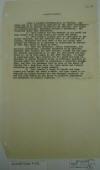
|
8. June 3, 1930.
G-2 Report on Sandino Situation,
Capt. Robert E. Cummings, Acting
Military Attaché, Mexico
"SANDINO
SITUATION ¶ After a careful
investigation in Yucatán,- one
which had to be discreetly made,
due to the State Department’s
instructions of October 26,
1929, to the American Vice
Consul at Progreso, Yucatán,
regarding Sandino’s movements,-
the following facts were
discovered: ¶ 1) That Sandino
and the members of his staff had
been absent from Mérida,
Yucatan, for about one month. ¶
2) That careful inquiry made of
Americans in the chicle
business, who had recently been
in the interior of Yucatan,
disclosed the fact that it was
not likely that Sandino was
hiding on an hacienda or
plantation in Yucatan or that
fact would be known by them. ¶
3) That the newspaper, police
department, and military
authorities, although reporting
to my reliable contacts that
Sandino had left Yucatan, either
did not know his present
whereabouts, or if they did
know, would not disclose it, or
by what means he had left
Yucatan. It might be mentioned
here that Sandino and his staff
had been accustomed to making
frequent trips to different
sections of Yucatan under the
pretext of purchasing a
hennequen [henequen] plantation,
and that any movement that he
made to the coast of Yucatan for
a departure from the State would
not attract attention or cause
any undue comment. ¶ 4) That
Sandino’s house in Mérida had
been closed and locked for about
a month, and that since it is
reported he always carries his
own personal servants, no one
was left behind in the house to
question concerning his
movements or present location."
|
|
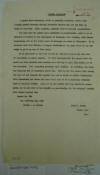
|
9. May 23, 1930.
G-2 Report on Sandino Situation,
Major Fred T. Cruse, Military
Attaché, San José.
"SANDINO
SITUATION ¶ A report from
Guatemala, which is probably
accurate, states that Sandino
passed secretly through
Guatemala between May 1st and
3rd, en route to Salvador. Other
reports, indicate that he
reached Zacatecoluca. ¶ Two days
ago the papers here contained an
announcement, said to be an
official statement by the
Government of Honduras, that
Sandino, with eleven companions,
was on the North coast of
Honduras en route to Nicaragua.
It is probable that with Marines
no longer stationed on the East
coast he may attempt to go in by
way of Coco river. ¶ It is
difficult to say what he can do,
should he reach his old area of
operations in Nueva Segovia. He
left Nicaragua for the reason
that the point had been reached
when natives were willing to
give information as to his
location. That condition
probably still exists. In
addition, the Guardia Nacional
has no illusions about him. This
is for the reason that during
the year of his absence the
Guardia has had to fight so
called Sandinistas like
Altamirano and Ortez and have
found them to be a perfectly
familiar type of vicious bandit.
Also, it is not likely that any
favorable propaganda can be put
over in his behalf, as
practically all his original
backers have turned against him.
¶ Report No. 729 ¶ San José--May
23, 1930 ¶ Source – As stated ¶
Fred T. Cruse, ¶ Major, G.S. ¶
M.A."
|
|
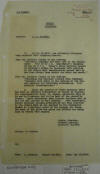
|
10. May 23, 1930.
G-2 Report on C. A. Sandino,
Col. Gordon Johnston, Military
Attaché, Mexico City.
"G-2
Report ¶ 3850-a ¶ MEXICO ¶
POLITICAL ¶ SUBJECT: C. A.
SANDINO. ¶ 1. On May 16, 1930,
the following telegrams were
received from Progreso, Yucatán:
¶ From the American Consul to
the Embassy: ¶ “Following
telegram has been sent to the
Department: ‘May 15 10 A M.
Department’s telegram of May 14
6 P M. Today’s press contains
report of Sandino’s return to
Nicaragua with notation to the
effect that investigation proves
that he has been absent from
Mérida for about one month.’” ¶
From the American Consul to the
Embassy: ¶ “Following for
Military Attaché from Cummings:
‘Telegram sent today to the
Embassy by the Consul contains
all available information. Will
continue investigation.’” ¶ 2.
Since the receipt of these
messages there has been no
official information in regard
to Sandino. His representative
here, Dr. Zepeda, maintains that
he is now in Nicaragua and at
the head of the guerrilla
forces. Press despatches from
Managua indicate that he has not
yet arrived in that country.
From unofficial, fairly reliable
sources, information has been
received to the effect that he
was carried to the Guatemalan
border by a military pilot of
the Mexican Air Force. The name
of the pilot was given and
efforts are being made to verify
this report. ¶ Gordon Johnston,
¶ Colonel, Cavalry, ¶ Military
Attaché. ¶ Source: As stated. ¶
J/p ¶ From: M.A.Mexico. ¶ Report
No. 2911. ¶ Date: May 23, 1930."
|
|
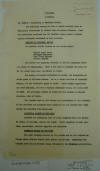
|
11.
May
21, 1930. G-2 Report on
Conditions on Honduran Border,
Major Fred T. Cruse, Military
Attaché, San José, p. 1.
"NICARAGUA
¶ POLITICAL ¶ No. 3020-d –
Conditions on Honduran Border. ¶
The following summary is from a
report recently made to
Nicaraguan authorities by
Colonel Juan Francisco Olivares.
From the localities mentioned
and the familiar names given I
believe Colonel Olivares’
statement is very accurate. ¶
SUMMARY OF OLIVARES’ REPORT
¶ The present bandit leaders on
the border are:-- ¶ Miguel Angel
Ortez ¶ Ferbonio Baquedano ¶
Juan Pablo Umanzor ¶ Carlos
Salgado. ¶ The latter was
captured recently by General
Alejandro Plata and taken to
Tegucigalpa. After a few days he
escaped and again is in the
bandit area near San Marcos de
Colon. ¶ The center of bandit
activities is Danli, the
Comandante of which place is
Gilberto Gamero. He is a close
relative of Leopoldo Gamero, who
was Sandino’s Agent in Danli.
Other bandit supports are José
Idiaquez, who was a Sandino
messenger during the early part
of 1928. The principal source of
funds for the bandits is Manuel
Raudales, also of Danli. ¶ The
bandits work in the fields and
plantations in the vicinity of
the frontier and assemble when
called on by the leaders for
raids across the frontier into
Nicaragua. ¶
PRINCIPAL SOURCE OF SUPPLIES
¶ Bandits are obtaining most of
their supplies from San Marcos
de Colon, El Paraiso, Alauca and
Danli. These supplies include
pistols, ammunition, medical
supplies and eatables. ¶
HONDURAN FORCES ON FRONTIER
¶ The only Honduran forces on
the border are at San Antonio de
Flores where Colonel Rafael Lara
Licona has 27 men. Naturally the
bandits come and go without
being bothered by the Honduran
authorities. . . . "
|
|
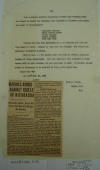
|
12. May 21, 1930.
G-2 Report on Conditions on
Honduran Border, Major Fred T.
Cruse, Military Attaché, San
José, p. 2.
"
. . . When Sandino’s personal
supporters crossed into Honduras
after his flight to Mexico the
following were captured by
Honduran authorities and taken
to Tegucigalpa:-- ¶ Francisco
Estrada ¶ Pedro Antonio Irias ¶
Carlos Salgado ¶ Carlos Quesada
¶ José León Díaz ¶ Estrada and
Diaz were permitted to go to
Salvador and have not been heard
of since. Salgado is back with
the bandits. The others are
scattered throughout Honduras. ¶
Note by M.A. - - For months
there has been no mention among
the bandits of being
Sandinistas. With his departure
they reverted to their former
role of pure bandits, and are
operating as such. If Sandino
should return to Nicaragua it is
doubtful of they would rejoin
him. ¶ Report No. 724 ¶ San
José--May 21, 1930 ¶ Fred T.
Cruse, ¶ Major, G.S. ¶ M.A. ¶
MARINES ARMED AGAINST
REBELS IN NICARAGUA ¶ Situation
Quiet, Says Admiral, but Warship
Brings Air Bombs. ¶ BY
JULIAN F. HAAS. ¶ SPECIAL CABLE
¶ To The Chicago Daily News
Foreign Service. ¶ Copyright,
1930, The Chicago Daily News,
Inc. ¶ Panama City, June
13.—While Admiral Edward
Campbell, commanding the naval
forces in Nicaragua, informs The
Chicago Daily News correspondent
of restored peace along the
eastern coast of the little
republic, precautions are being
undertaken to prevent a
recurrence of outlawry. A fresh
supply of “live” aerial bonds to
combat bandit activities,
supplementing the marine landing
party, is to be unloaded at
Corinto by the air squadron
vessel Aroostook of the American
battle fleet, now en route to
California. ¶ Banditry in
eastern Nicaragua has ceased and
it is believed that the gangs
that raided the Neptune mine
three weeks ago under August
Sandino’s favorite lieutenant,
Altimirano, have retired to the
interior, according to Admiral
Campbell, who returned last
night from an inspection trip to
Nicaragua. ¶ Sandino
Reported Back. ¶ “It is
pretty well accepted that
Sandino is back in Nicaragua,
but he has not shown his hand,”
declared Admiral Campbell. “His
countrymen have lost interest in
him and are beginning to realize
that he has nothing to offer
them. Indeed, Nicaraguans
generally now feel that they
could derive no benefits from
backing Sandino; rather they
would only be harming their
country.” ¶ Admiral Campbell
asserted that only 200
Nicaraguan guardsmen remained on
the east coast, plus a small
detachment posted at the mines,
and that the marines ashore and
sailors aboard the American
cruiser Asheville were standing
by. ¶ Bandits Are
Peaceful. ¶
Confirmation of the peaceful
conditions comes in reports from
the eastern cities and mining
and fruit area, where it is
considered that the recent
roving bandits consisted of
workmen looking for jobs. There
are also denials of rumors that
ammunition is being landed at
isolated points of the coast
destined for either bandits or
revolutionists. ¶ Altimirano’s
band of 150, including a few
small boys, which looted the
Neptune mine, gave every
appearance of the old Sandino
army. Its members did not
indulge in liquor nor attempt to
abduct women and altogether they
were well disciplined, according
to naval reports. ¶ Some of the
men wore red and black kerchiefs
emblematic of the Sandinistas.
However, they were poorly armed
and what few rifles they had
were obsolete."
|
|
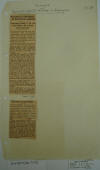
|
13. May 17 & 21,
1930. Press clippings:
May 17, "Nicaragua Unstirred by
Return of Sandino.
Government Doubts if He Can
Unite Outlaws, but Is Ready to
Increase Guard,"
New York
Times, and May
21, "Seizures in Nicaragua
—
Several, Including a Mexican
General, Suspected of Aiding
Sandino,
New York Times.
"NICARAGUA
UNSTIRRED BY RETURN OF SANDINO ¶
Government Doubts if He Can
Unite Outlaws, but Is Ready to
Increase Guard. ¶ By
Tropical Radio to THE NEW YORK
TIMES ¶ MANAGUA, May
17.—Augustus Cesar Sandino, the
noted Nicaraguan outlaw who was
seen recently in Honduras, has
probably crossed the border into
Nicaraguan territory, according
to information received in
official quarters here. ¶
Officials here believe his
return, if true, will not
materially affect the situation,
which is well controlled. Unless
Sandino is able to organize
guerilla warfare more
effectively than on his previous
attemptin [attempt in] 1926-27,
the situation will remain
unchanged. ¶ Depredations in the
northern provinces are carried
out under many leaders, working
independently, each keeping more
or less to his own territory,
and the authorities believe it
impossible to unite these
independent bands under one
head. ¶ However, if Sandino
should accomplish unification
the Nicaraguan Government feels
itself well equipped to cope
with the situation, and
officials are not alarmed by the
news of Sandino’s return. It has
long been expected, and the
Nicaraguan Government already
has authorized General Douglas
McDougal, the commander of the
Nicaraguan National Guard, to
increase the guard sufficiently
to meet any situation. It is,
therefore, felt that the only
probable result of Sandino’s
return would be a slight
stimulation to a few
disheartened bandits. ¶ The
United States Marine Corps force
in Nicaragua is reported to be
unaffected by the news of
Sandino’s arrival. ¶ Local
newspapers say the Honduran
Government is cooperating with
Nicaragua against banditry,
endeavoring to aid in keeping
bandits from crossing the
frontier for safety. ¶
SEIZURES IN NICARAGUA. ¶
Several, Including a Mexican
General, Suspected of Aiding
Sandino. ¶ By Tropical
Radio to THE NEW YORK TIMES. ¶
MANAGUA, Nicaragua, May
21.—Several arrests, including
those of a Mexican calling
himself General Emilio Bermejo,
a Spaniard and the family of
Miguel Ortiz [Ortez], a former
Sandino lieutenant, were made
Saturday. ¶ Those arrested are
suspected of being Sandino’s
agents. Some were released today
but it is understood that the
foreigners may be deported. ¶
Semi-official information
received today is that bandits
in the northern provinces are
receiving aid from Danli, a
Honduran town near the border.
It is believed that the bandits
have a clearing house for stolen
goods from Nicaragua near Danli.
¶ It has been announced at the
presidential palace that reports
of Sandino’s return to Nicaragua
have not been confirmed.-"
|
|

|
14. November 13, 1933.
G-2 Report by Major A. R. Harris, Military
Attaché,
San José.
"The Coco River has at least
three names, used locally in
different sections and also
appearing on different maps.
This same river is called in
different places: the 'Segovia
River' (Rio Segovia), the Wanks
River, and The Coco River (Rio
Coco). The term Coco River is
used by most foreigners, the
term Segovia is used by many
Nicaraguans; and the term Wanks
is used by the Caribs and
negroes along the Mosquito
Coast. It is belieed that the
name Coco River is the most
widely used."
|
|
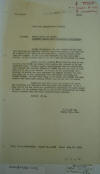
|
15. July 27, 1933.
G-2 Report on Sandino's Former
Chief Lieutenant Assassinated,
Major A. R. Harris, Military
Attaché, San José.
"G-2
Report ¶ 2,700. ¶ NICARAGUA
(Population & Social) ¶ Subject:
Public Order and Safety. ¶
Sandino’s Former Chief
Lieutenant Assassinated. ¶
Pedrón Altamirano, the most
feared and the most
bloodthirsthy [bloodthirsty] of
Sandino’s “Jefes”, was
assassinated a few days ago at a
place called Bocay on the Coco
River, halfway between Santa
Cruz and Waspuk. At the same
time Pedron’s two sons were also
killed. At the present time it
is not known who committed the
deed. ¶ About the time Sandino
threw down his arms it was
rumored that Pedrón had broken
with Sandino and refused to
follow Sandino’s lead. Further
reports (unconfirmed) were in
circulation that Sandino was
somewhat afraid of Pedrón and
was not able to control him to
any great extent. It is not at
all improbably that Sandino,
following the most approved “Al
Capone” methods for putting away
one of his lieutenants who
threatened his rule, had Pedrón
killed. On the other hand, it is
known that Pedrón had many
enemies who would like nothing
better than to cut out his
heart. ¶ Bocay has been for
years the jumping off place for
criminals and murderers from
Nicaragua and Honduras. It is a
very out of the way place and
practically impossible to reach
except by boat. At the present
time it is one of the
headquarters in which General
Sandino runs his river
transportation company. ¶
Source: Press. ¶ A. R. Harris, ¶
Major, G.S., M.A. ¶ From: M. A.
Costa Rica ¶ Report No. 2,127 ¶
Date: July 27, 1933." [NOTE:
a false
report, probably a scheme by
Pedrón to cover his tracks; see
PEDRÓN ]
|
|
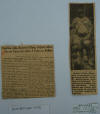
|
16. May 17, 1935.
"Sandino Aide, Reported Slain,
Is Quite Alive; Terror Turns Up
After 2 Years as Robber,"
New York Times.
"Sandino
Aide, Reported Slain, Is Quite
Alive; Terror Turns Up After 2
Years as Robber ¶
Special Cable to THE NEW YORK
TIMES. ¶ MANAGUA, Nicaragua, May
17.—General Pedro Altamirano,
nicknamed Pedron, who was
reported assassinated with his
two sons almost two years ago,
is now said by the Nicaraguan
National Guard to be very much
alive. ¶ For more than three
months guard patrol had searched
for a small group of bandits
headed by General Altamirano and
Simon Gonzalez. The bandits were
finally located near Siuna. In a
sharp half-hour skirmish two
bandits were killed, three were
wounded and several were
captured. In addition guns and
ammunition were seized. The
bandit leaders, who had been
warned, escaped. ¶ As one of
Augusto C. Sandino’s generals,
Altamirano, fearless and cruel,
was considered the terror of the
northern departments. But since
the death of Sandino he has been
unable to make a living and has
resorted to petty banditry and
is no longer feared. ¶ On July
26, 1933, Pedro Altamirano, who
was Augusto C. Sandino’s chief
general, was reported to have
been assassinated by
unidentified enemies a few days
earlier near Bocay in the
Department of Jinotega. ¶ In the
northern departments General
Altamirano’s physical prowess
caused him to be feared even
more than was General Sandino.
It was his habit to slay his
enemies with hacks of the
machete, termed by him “corte de
chaleco,” using three strokes,
one on the back of the head and
the others on each side of the
neck, roughly outlining the form
of a coat collar. ¶ Altamirano
had been sought by United States
Marines for five years, but
always had escaped. He is the
last and most ferocious of the
bandit chiefs who had joined
Sandino in 1927-28 and was a bad
man and killer from his youth.
His band numbered from 75 to 150
men. ¶ PEDRÓN - (Pedro
Altamirano), el cual
según las bases propuestas por
Sandino, sería el jefe del único
ejército de Nicaragua, formado
por las actuales tropas
sandinistas. Según Sandino, ese
ejército será el encargado de
'mantener el completo orden en
la República'."
|
|
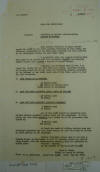
|
17. May 25, 1933.
G-2 Report on Current Situation,
Alex A. Cohen, Clerk in charge
of office in the absence of the
Military Attaché, San José.
"G-2
Report ¶ 3,020-b ¶ NICARAGUA
(Political) ¶ Subject: Stability
of Present Administration. ¶
Current Situation. ¶ With
further reference to Major
Harris’ report No. 2,043 on the
above subject, forwarded by this
pouch, the following information
on the Nicaraguan situation has
been gathered by the undersigned
during the past eight days. ¶ A
persistent rumor has reached
Honduras from Nicaragua to the
effect that Vice President
Espinoza has secretly allied
himself with Sandino – against
President Sacasa. ¶ Regarding
the statement made in Par. 1 of
report No. 2,040, May 19, 1933
from this office, regarding
Sandino not having turned in all
his arms; the following figures,
published in “La Tribuna” of San
José, under date of May 21st,
appear to bear out this
assertion. ¶ 1.
Arms turned in by Sandino.
¶ 21 Machine guns ¶ 345 Rifles
of various makes ¶ 2,129 rounds
of ammunition ¶ 2.
Arms left with Sandino’s police
force of 100 men ¶ 15
Machine guns ¶ 82 Rifles ¶ 3.
Arms left with Sandino’s
personal bodyguard ¶ 4
Machine guns ¶ 12 Rifles ¶ All
of the 2,129 rounds of
ammunition were divided between
Sandino’s police force and his
bodyguard. In other words, the
arms which actually were turned
in to the government consisted
of: ¶ 3 Machine guns ¶ 251
Rifles ¶ At least one cache of
rifles, machine guns and
telegraph apparatus has been
found during the past few weeks
by national guard patrols in the
Segovias. ¶ Another informant
stated that if and when a
blow-up occurs in Nicaragua, it
will be entirely within the
Liberal Party itself, with the
Conservatives watching from the
sidelines in silent glee. ¶
Sources: Various. ¶ IN THE
ABSENCE OF THE MILITARY ATTACHÉ:
¶ Alex A. Cohen, ¶ Clerk, in
charge of office. ¶ From: M. A.
Costa Rica ¶ Report No. 2,051 ¶
Date: May 25, 1933."
|
|
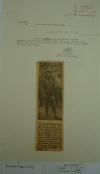
|
18. March 30,
1933. G-2 Report on Juan
Altamirano, Major A. R. Harris,
Military Attaché, San José.
"Here is Colonel Juan
Altamirano, reported executed by
Sandino for refusal to obey
orders, but actually only shot
in the arm. He is at present
alive and 'kicking' at San
Rafael del Norte, Nicaragua."
Caption of press
clipping, n.d.: "El
coronel sandinista JUAN
ALTAMIRANO, a quien
Sandino mandó a fusilar, pero el
cual quedó vivo después de la
fusilación porque la bala
solamente le hirió un brazo.
Se dice que el pelotón
sandinista encargado de la
ejecución apuntó mal
deliberamente para no cumplir la
orden de Sandino. El
coronel Altamirano, está vive en
San Rafael del Norte."
|
|
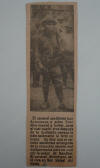
|
19.
ca. March 1933, Press
clipping, n.d. "El coronel sandinista JUAN ALTAMIRANO."
|
|
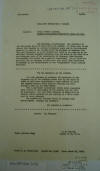
|
20. March 23,
1933. G-2 Report, "Sandino
Establishes Cooperative among
his Men," Major A. R. Harris,
Military Attaché, San José, p. 1.
"G-2
Report. ¶ 2,700. ¶ NICARAGUA
(Population & Social) ¶ Subject:
Public Order & Safety. ¶ Sandino
Establishes Cooperative among
his Men. ¶ The following
advertisement was published in
the Nicaraguan Press at the
request of Sandino. It would
seem to indicate that Sandino is
serious in keeping peace and is
intelligently planning to open
up the country which he proposes
to colonize with his old
followers. By river traffic and
roads he can open up an
unofficial “Sandino Kingdom”
extending East and South of the
Coco River and embracing most of
the Departments of Jinotega,
Cabo Gracias, Prinzapolka, Rio
Grande and a part of Bluefields.
All of these Departments are so
sparsely settled that they would
lend themselves imminently to
the establishment of the
“Cooperativa” which Sandino
mentions. ¶ “TO THE MERCHANTS OF
THE COUNTRY. ¶ “We take pleasure
in advising the merchants of the
Segovias and of the Atlantic
Coast that by the first of April
we will have established a rapid
service of boats and pitpans
between Santa Cruz de Jinotega
and Cabo Gracias a Dios on the
Coco River. ¶ “Our cooperative
association offers every
guarantee with regards to
efficiency of the service and
the life of passengers. The road
from Jinotega to Santa Cruz is
already being repaired and the
opening of a first class road in
being planned. ¶ “We request the
National Press to publish this
announcement. Country and
Liberty.” ¶ (s) Augusto C.
Sandino.” ¶ Source: “La Noticia”
¶ Encl. (Outline Map) ¶ A. R.
Harris, ¶ Major, G. S., M. A. ¶
From: M. A. Costa Rica ¶ Report
No. 1,989 ¶ Date: March 23,
1933."
|
|

|
21. March 23,
1933. G-2 Report, "Sandino
Establishes Cooperative among
his Men," sketch map enclosure,
Major A. R. Harris, Military
Attaché, San José, p. 2.
"Area shaded in red shows
approximate zone of 'Sandino
influence'."
|
|

|
22. April-May
1933. Press clippings.
"Sandino
Disillusioned By Sacasa, Sayss
[Says] Agent ¶ Government
Accused of Ignoring Its Peace
Pledges ¶ MEXICO CITY,
April 27 (UP).—Dr. Pedro Jose
Zepeda, foreign representative
of General Cesar Agusto Sandino,
charged in an interview here
today that President Juan B.
Sacasa of Nicaragua has so far
failed to carry out the program
of financial reform which
Sandino relied upon seeing
effected when he disbanded his
army early this year. ¶ The
President’s inactivity, Dr.
Zepeda declared, has dampened
the high hopes with which the
peace pact was signed on
February 2. ¶ “While General
Sandino scrupulously performs
his obligations under the pact,
devoting himself entirely to the
development of the agricultural
community along the Cocos River
[Coco River], the Managua
government is idle, its program
apparently neglected,” Dr.
Zepeda stated. He pointed out
that President Sacasa was to
have taken steps toward
repossession of the Nicaraguan
railways and other measures for
the purpose of restoring
Nicaragua’s control over banks
and customs houses. ¶ Dr. Zepeda
said that General Sandino had no
intention of resuming his
insurrectionist activities
because of the government’s
failure to fulfill the peace
agreement. ¶ Americans
Manage Railways ¶
Dispatches describing the peace
terms signed by Sandino and
Sacasa on February 2, a month
after the last United States
Marines had been withdrawn from
Nicaragua, made no mention of
railways, banks or customs
houses. The Pacific Railway, 159
miles in length, Nicaragua’s
principal railway, is government
property, but is managed by an
American corporation. ¶
SANDINO PLANS NEW PARTY ¶ He and
Ex-President Will Form a Labor
Group in Nicaragua. ¶
By Tropical Radio to THE NEW
YORK TIMES. ¶ MANAGUA,
Nicaragua, April 28.—The press
announced today that General
Augusto Sandino and former
President Bartolome Martinez
were planning to form a new
political party called the
National Labor party. ¶ The
government has sent General
Sandino, the former rebel
leader, a large quantity of
foodstuffs for his former
soldiers who are engaged in
agriculture and placer mining at
Bocay on the Coco River. ¶
Sandino Explains Truce ¶
Made Peace With Sacas ato
[Sacasa to] Prevent Return of
Marines, He Says ¶
By Cable to the Herald Tribune ¶
Copyright, 1933, New York
Tribune Inc. ¶ MEXICO CITY, May
2.—General Cesar Agusto Sandino
signed his recent peace treaty
with President Juan B. Sacasa of
Nicaragua, not because he was
politically in accord with the
Managua administration, but in
order to “prevent another
foreign invasion”—that is, the
return of the United States
marines, according to a
statement published here today
over Sandino’s signature. ¶ “I
am not affiliated with the
present government,” Sandino is
quoted as asserting. “I signed
the peace pact to avoid a return
of the armed intervention which
had just been withdrawn. ¶ “Our
government is not yet
autonomous, because a political
and economic intervention still
exists, and it should be noted
that the military components of
the country who operated in
alliance with th einvaders [the
invaders] continue to be our
enemies.” ¶ Sandino and
Sacasa Confer; Ex-Rebels Gain as
Farmers ¶ Wireless to
THE NEW YORK TIMES. ¶ MANAGUA,
Nicaragua, May 20.—The former
rebel leader, General Augusto
Sandino, who is now supervising
the agricultural colony at
Bocay, arrived in Managua
yesterday with his father to
confer with President Sacasa
regarding the interpretation of
the peace pacts signed in
February. ¶ This visit is the
first time General Sandino has
been in Managua since February.
¶ He seemed satisfied with the
progress of his “muchachos,” or
former rebel soldiers, who are
now engaged in clearing land and
planting crops. ¶
SANDINO DECRIES COUNTRY’S STATUS
¶ Says Intervention, Political
and Economic, Exists in
Nicaragua. ¶ By the
Associated Press. ¶ SAN
SALVADOR, El Salvador, May
23.—Gen. Augusto Sandino, called
both patriot and bandit during
his years of insurgence against
American administrative
activities in Nicaragua, was
quoted in El Diario Latino
yesterday as saying, “Economic
and political intervention in
Nicaragua has not disappeared.”
¶ Sandino made good his
oft-repeated promise by laying
down his arms when the last
American Marines left Nicaragua
in January and entering into a
peace agreement with the new
Nicaraguan government at that
time. ¶ In a letter published in
the newspaper here, Sandino said
President Sacasa of Nicaragua is
“himself a witness to the fact
that economic and political
intervention in Nicaragua has
not disappeared, which makes it
impossible for us to say
Nicaragua enjoys absolute
autonomy.” ¶ Among other things,
Sandino said: ¶ “My temperament
is that of a dictator, and I
would be a terrible, but
generous dictator.” ¶ Dr. Pedro
Zepeda, Sandino’s Mexican
representative, said recently
that Sandino’s followers were
disappointed because President
Sacasa had not kept alleged
promises he made when the
Sandino army laid down its arms.
¶ He said that the return of
customs houses and railroads and
other economic measures had been
pledged, but that President
Sacasa was handicapped by a bad
situation left by his
predecessors. ¶ The Sandinistas
have no intention of
embarrassing the government and
will give the President more
time, Dr. Zepeda said. ¶
SANDINO RETURNS TO POST ¶
Ex-Rebel Says He Will Continue
to Form New Nicaraguan Party.
¶ Wireless to THE NEW YORK
TIMES. ¶ MANAGUA, Nicaragua, May
23.—General Augusto Sandino,
former rebel chieftain who now
is the leader of an agricultural
colony on the Coco River,
returned to Bocay yesterday. ¶
In a statement to the press
before leaving Managua he
announced that, while President
Sacasa considered his formation
of a new party inopportune, he
would continue his efforts. He
said he would continue to give
President Sacasa moral support."
|
|
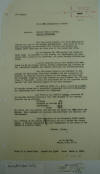
|
23. March 1, 1933.
G-2 Report on Current Situation,
Major A. R. Harris, Military
Attaché, San José.
"The
Nicaraguan Congress has voted
$120,000.00 towards the cost of
the Sandino pacification.
This money is to be used
principally in connection with
clothing and feeding the bandits
after they turn in their arms at
San Rafael del Norte. Up
to February 16, 625 bandits had
turned in their arms. In
addition to this number, 100
Sandinistas had been formed into
a military organization, and
given Guardia uniforms and
shoes. A press dispatch
stated dthat Sandino had
executed two of his former
chiefs, Colonel Altamirano (no
relation to the redoubtable
Pedrón) and Captain Olivares,
for insubordination. The
Nicaraguan Congress has included
in its amnesty the Nicaraguan
lieutenant Gonzáles and his
companions who murdered an
American Guardia officer in his
sleep, and fled from the
country. Congress has also
decided to grant Sandino the
official title of 'General'.
During the discussion one of the
deputies called Sandino 'the
most glorious figure of the 20th
century.' On February
13th, at a place called El
Arraján, 25 Guardia troops had a
successful engagement with 200
Sandinistas. The Sandinistas
were defeated and dispersed.
On February 11, General Somoza,
commander of the Guardia
Nacional announced that the
strength of the Guardia Nacional
was as follows: Officers:
230. Enlisted: 2436.
Auxiliaries: 1489. Total:
4123. He stated that the
average cost per man for this
force was $28.16. This
included all expenses connected
with the military establishment.
1,000 employees of the Bragman's
Bluff Lumber Co., working on the
banana plantations, are on
strike for higher wages. A
Guardia detachment has been
dispatched to the scene of the
strike to preserve order.
Source: Press."
|
|
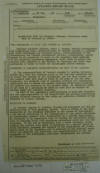
|
24.
February 17, 1933.
G-2 Translation of article in
La Noticia, Managua
(Feb 4), Naval Attaché,
Tegucigalpa, p. 1.
"THE
CONVENTION OF PEACE WITH AUGUSTO
C. SANDINO: ¶ Salvador Calderon
Ramirez, Pedro J. Zepeda,
Horacio Portocarrero and
Escolastico Lara,
Representatives of General
Augusto C. Sandino; and David
Stadthagen and Crisanto Sacasa,
representatives of the
Conservative and Liberal
Nationalist parties,
respectively, openly agreed to
the necessity of peace in the
Republic, have convened in the
following harmonious agreement,
which tends to cement the
sincere love inspired by the
welfare of Nicaragua and those
high sentiments of honor to
which the undersigned render
hommage [homage]. ¶ STATEMENT OF
SANDINO’S REPRESENTATIVES AND
THAT OF THE PARTIES: ¶ 1. The
representatives of General
Augusto C. Sandino declared,
before all, that the mission
which he and his army undertook
was to assure the liberty of the
Fatherland; and for that reason,
at the present time they wish to
state in the name of the one
they represent, his absolute
lack of personal interest and
irrevocable resolution not to
demand nor accept anything which
might restrict the motives and
movements of his private life.
He therefore wants to set down
as a principle or immobile base
that he aspires to neither glory
nor material benefits. ¶ In view
of the preceeding [preceding]
manifestations of elevated
disinterest the representatives
of the conservative and liberal
nationalist parties rendered
hommage [homage] to the noble
and patriotic attitude of the
referred to General Sandino. ¶
STATEMENT OF SANDINO: ¶ 2.
General Augusto C. Sandino,
through his delegates and the
representatives of both parties,
stated: that in virtue of the
desoccupation of the national
territory by the forces of
foreigners, a new era of
renovation of the fundamentals
of our public existence is
undoubtedly opened; that,
disciplined by a painful
experience, he considers it an
imperative duty to fortify the
collective sentiment of autonomy
which with unanimous enthusiasm
moves all the Nicaraguans. To
the end of increasing such a
noble tendency, those signing
the present pact agree to
designate as a capital point in
their political programs the
respect of the Consitution
[Constitution] and fundamental
laws of the Republic, and to
maintain by all rational means
which are adecuate [adequate]
and justified, the
resplendishment in all its
abundance of the soverignty
[sovereignty], political
independence and economy of
Nicaragua. ¶ (Continued on PAGE
TWO------- . . . "
|
|
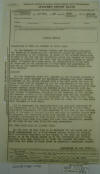
|
25.
February 17, 1933.
G-2 Translation of article in
La Noticia, Managua
(Feb 4), Naval Attaché,
Tegucigalpa, p. 2. "
. . . DEDICATION TO WORK AND
ABANDON OF THEIR ARMS: ¶ 3. The
delegates of General Sandino and
the parties recognize the
benefits of cementing in a
practical manner the peace of
all the territory of the
Republic, by means of the
earnest dedication to work of
all the men now soldiering under
the command of General Augusto
C. Sandino and the same time the
gradual abandon of their arms.
To secure by a sure means the
normalization of the life of
these men in the activities of
work under the guarantees of law
and of the constituted
authorities, the following means
have been adopted: ¶ AMNESTY: ¶
(a) The Executive power will
present to the National Congress
a project to grant amnesty for
political offences and civil
ofences [offences] committed in
the period elapsed from 4 May
1927 until the date of today
which will be enjoyed by all the
individuals of the army of
General Sandino who within
fifteen days of the promulgation
of such decree deposit their
arms and equally so all those
who with the direct
authorization of General Sandino
promise to deposit their arms
within threemonths [three
months], including in the
benefits of the amnesty one
hundred persons of the
aforementioned army who may
conserve their arms temporarily
for the vigilance of the zone of
free land in which they will be
permitted to farm and work, all
of whom shall have belonged to
said army. ¶ (b) To represent
the administrative and military
authority of the Government of
the Republic in the Departments
of the North, comprising
especially the zone destined to
the work of the individuals of
the army of General Sandino and
also to receive theirs [their?]
arms by degrees, the Executive
power will appoint as its
delegate Don Sofonías
Salvatierra to whom General
Sandino will deliver within the
twenty days from this date, not
less than twenty-five percent of
the arms of any kind which his
army possesses. ¶ THE ZONE WHICH
WILL BE ALLOTED [ALLOTTED] THEM:
¶ (c) The zone of free land to
be destined for the labor and to
which subparagraph (a) of this
decree refers, should be located
with sufficient amplitude in the
valley of the Coco (or Segovia)
river, or in the region agreed
to by the Government and General
Sandino; this zone should be at
least ten leagues (30 miles)
distant from the towns in which
there is actually a municipal
regime. ¶ (Continued on PAGE
THREE--- . . . "
|
|
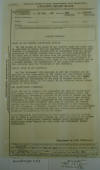
|
26.
February 17, 1933.
G-2 Translation of article in
La Noticia, Managua
(Feb 4), Naval Attaché,
Tegucigalpa, p. 3.
"
. . . GUARD OF ONE HUNDRED
SANDINISTAS CHOSEN: ¶ (d) The
chiefs of the guard of one
hundred armed men which will be
permitted to exist, will be
appointed by the Government as
auxiliaries in emergency,
chosing [choosing] them in
accordance with the
recommendations of General
Sandino from among the more
capacitated of his army; but if
after one year from the
promulgation of this decree of
amnesty it should become
convenient, in the judgement
[judgment] of the Government, to
maintain said guard of one
hundred armed men or a smaller
number, the appointment of the
respective chiefs will fall
directly upon the President of
the Republic. ¶ PUBLIC WORKS IN
THE SEGOVIAS: ¶ (e) The
Government will maintain in all
the Republic and especially in
the Departments of the North,
for the minimum period of one
year, projects for public labor
in which they will enjoy
preferably the individuals of
the army of General Sandino who
should request work, and who
submit to the ordinary regime
established in those works. ¶
THE HOSTILITIES CONCLUDED: ¶ 4.
By the act of signing this
agreement all form of
hostilities will cease between
the two parties to this
document, i.e., the
Constitutional Government
presided by Dr. Juan B. Sacasa
and the forces of General
Augusto C. Sandino, for
immediate and supreme guarantees
of lives and properties of the
nicaraguans [Nicaraguans]; and
once becoming definitely
effective this pact on approval
by General Sandino and by the
acceptance of the President of
the Republic, all the followers
of General Sandino will come
under the guarantees of the
constituted authorities and as a
consequence obligated to
cooperate in conserving the
public order. ¶ 5. To facilitate
the disarming of the forces of
General Sandino and to offer a
provisional retreat for them the
town of San Rafael del Norte is
designated, General Sandino
being responsible for
maintaining order during the
time which the Government judges
convenient. ¶ (Continued on PAGE
FOUR------ . . . "
|
|
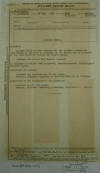
|
27.
February 17, 1933.
G-2 Translation of article in
La Noticia, Managua
(Feb 4), Naval Attaché,
Tegucigalpa, p. 4.
"
. . . APPROVAL: ¶ In good faith
of that treated the two parties
thereto do sign hereby in the
city of Managua, on the second
day of February of the year
nineteen hundred and thrity
[thirty] three. ¶ (Between the
lines) For General Sandino: ¶ S.
Calderon R.--Pedro José
Zepeda--H. Portocarrero--D.
Stadthagen--Crisanto Sacasa. ¶
ACCEPTANCE BY SANDINO: ¶
Approved and ratified in all its
parts, ¶ Managua, National
District, 2 February 1933,- A.
C. Sandino. ¶ ACCEPTANCE BY THE
PRESIDENT OF THE REPUBLIC: ¶
Accepted in all its parts. ¶
Managua, National District, 2
February 1933,- Juan B. Sacasa."
|
|
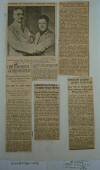
|
28. February 1933.
Press Clippings.
"PRESIDENT
OF NICARAGUA EMBRACES SANDINO.
¶ Associated Press Photo. ¶
Cordial Greetings Mark
the Signing of Peace Pact on
Feb. 2, Ending Hostilities Which
Had Persisted for Several Years.
¶ 1,800 SANDINISTAS GATHER TO
GIVE UP ¶ Nicaraguan Rebels
Seize Many Cattle, but Sandino
Orders Return to Owners. ¶ 100
MEN TO KEEP ARMS ¶ Balance Will
Be Turned Over to Government in
Three Months—Border Patrol in
Clash. ¶ Special Cable
to THE NEW YORK TIMES. ¶
MANAGUA, Nicaragua, Feb.
7.—About 1,800 Sandinistas have
already gathered in San Rafael
del Norte to lay down their arms
in accordance with the peace
terms reached with their leader,
General Agusto Sandino, it is
reported here. ¶ Among them are
several rebel Generals, it is
said, including Generals
Unmanzor [Umanzor], Gomez,
Morales, Peralta, Estrada, Irias
and others whose names are not
given. One known as Pedron or
“Big Peter” is said not to be
there. According to a rumor here
Pedron was bathed in tears
during General Sandino’s absence
in the capital from his men,
fearing his chief would be a
victim of foul play. No one
here, however, can imagine
Pedron in tears. ¶ Rebels led by
Pedron are declared to have
rounded up many head of cattle,
but General Sandino is said to
have ordered the animals
returned to their owners at
once, and to have directed his
men not to interfere any more on
coffee plantations. ¶ The
Sandinistas are expected to turn
in one-fourth of their arms very
soon and the balance, except
weapons for 100 men, within
three months. Pending the
execution of the peace agreement
in this respect, General Sandino
will represent the Nicaraguan
Government at San Rafael del
Norte. ¶ National Guard troops
have been removed from San
Rafael del Norte to reduce the
danger of a clash. ¶ A National
Guard patrol, it was learned
today, was attacked Saturday at
Jicomico, near the Honduran
border, by a band of about 200
Honduran rebels. The Guards are
said to have killed three,
captured thirteen, and wounded
many of the revolutionists in
the clash that followed, in
which the patrol was victorious.
¶ SANDINISTAS WARNED TO
MEET PEACE MOVE ¶ General Will
Help Guard Pursue Former
Nicaraguan Followers Unless Arms
Are Given Up. ¶ Special
Cable to THE NEW YORK TIMES. ¶
MANAGUA, Nicaragua, Feb. 8.—Any
groups of Sandinistas failing to
comply with orders of General
Augusto Sandino to report at San
Rafael del Norte, complying with
peace terms by giving up their
arms, will be pursued by the
National Guard with the full
cooperation of General Sandino,
it was said today. ¶ A report
that Sandino’s army of about
3,200 men is largely unarmed
except for machetes is
unconfirmed. ¶ The government
had paid high official honor to
General Reina, who was killed in
an airplane accident. ¶
Reorganizing of the police of
Managua under control of the
National Guard is under way and
will later be extended to all
other cities. ¶ Small rebel
groups are still assassinating,
mutilating and robbing, but
after the Sandino peace
arrangements are complete this
will not last long, the press
says. ¶ Terms of Peace Contract
In Nicaragua Announced ¶ The
terms of the new peace agreement
between Augusto Sandino and the
Nicaraguan Government have been
transmitted to the Department of
State Feb. 4. An announcement by
the Department of State follows
in full text: ¶ The American
Minister at Nicaragua, Mr.
Matthew Hanna, has informed the
Department of State that a peace
agreement was signed in Managua
on the night of Feb. 2, by
Sandino and accepted by
President Sacasa. The agreement
provides for the immediate
cessation of hostilities on the
basis of complete amnesty; the
immediate partial disarmament of
Sandino’s forces, to be
completed at the end of three
months, excepting 100 men for
the preservation or order
temporarily in the region along
the Coco River where Sandino’s
followers will be permitted to
settle on public lands. ¶ The
officers of these forces will be
named by Sandino and appointed
by the government as “emergency
auxiliaries.” The agreement also
provides for the inauguration of
a program of public works to
give employment to Sandino’s
followers for one year. ¶
Minister Hanna also reported
that President Sacasa and a
number of members of his
Government with whom Mr. Hanna
talked on Feb. 3 seemed pleased
with the outcome of the
negotiations. Minister Hanna
made known to President Sacasa
his gratification that President
Sacasa had reached an agrement
[agreement] in the matter
satisfactory to his government.
¶ Ambassador J. Reuben Clark Jr.
reported to the Department of
State that the Minister for
Foreign Affairs of Mexico had
sent a message on Feb. 4 to
President Sacasa, of Nicaragua,
which was intended to be the
equivalent of recognition of the
new Nicaraguan government and to
be the initial step toward the
resumption of diplomatic
relations between Mexico and
Nicaragua. (Issued by the
Department of State.) ¶
FORCES OF SANDINO ACCEPT PEACE
PACT ¶ Arms Will Be Exchanged
for Farm Implements at
Nicaraguan Meeting Place Today.
¶ MANAGUA, Nicaragua, Feb. 6
(AP).—The followers of General
Augusto Sandino have agreed to
comply with a peace settlement
reached last week with President
Sacasa, said a statement issued
today by a member of a
commission empowered by General
Sandino to carry on preliminary
negotiations. ¶ The statement,
issued by Dr. Pedro Jose Zepeda,
said that after leaving Managua
General Sandino went to his
headquarters in the mountains,
where his officers and soldiers
“unanimously accepted” the
agreement. ¶ Dr. Zepeda said
General Sandino intended to go
tomorrow to San Rafael del
Norte, where his troops will
begin laying down their arms. In
preparation for the laying down
of arms by the Sandino forces
the government is purchasing
farming implements and supplies
for them. ¶ Special to
THE NEW YORK TIMES. ¶
WASHINGTON, Feb. 6.—Secretary
Stimson and Foreign Minister
Arguello of Nicaragua have
exchanged congratulations on the
peace settlement made with
General Sandino. ¶ J. Reuben
Clark Jr., United States
Ambassador at Mexico City, today
reported that Mexico had
extended recognition to
Nicaragua and intended to resume
diplomatic relations, which were
severed after charges had been
made that Mexico was aiding
General Sandino."
|
|

|
29. February 1933.
Press Clippings.
"SANDINO
MEN SURRENDER. ¶ Nicaraguan
Agriculture Minister to
Officiate at Disarming.
¶ MANAGUA, Nicaragua, Feb. 9
(AP).—General Augusto Sandino,
who last week agreed to make
peace with the rest of the
country, today sent a message to
President Sacasa saying he has
concentrated 1,000 of his men at
San Rafael del Norte, ready to
lay down their arms in keeping
with the agreement. ¶ Sofonias
Salvatierra, Nicaraguan Minister
of Agriculture, who participated
in conferences which led to the
Liberal General’s decision, was
expected to arrive at San Rafael
del Norte with a delegation
today to officiate at the
disarming. ¶ Government reports
said scattered Sandino patrols
were coming down from the
mountains and surrendering to
authorities in the northern part
of the country. ¶
Sandino Executes 2 Officers As
Rebels and Warns Others
¶ Special Cable to THE NEW YORK
TIMES. ¶ MANAGUA, Nicaragua,
Feb. 10.—The press here reports
that General Augusto Sandino has
executed Colonel Juan Altamirano
and Captain Francisco Olivares
before a firing squad at San
Rafael del Norte for
insubordination. ¶ Socrates
Sandino, a brother of the
General then harangued the
Sandinistas, telling them they
must preserve law and order and
comply with the terms of the
agreement between General
Sandino and President Sacasa.
There are about a thousand
Sandinista troops at San Rafael
del Norte. ¶ The government has
sent the first instalment of
clothing and agricultural
implements to be used in
disbanding the rebels. ¶ Colonel
Juan Altamirano was a brother of
General Pedron Altamirano, known
as “Big Peter.” ¶
Sandino Orders Two Rebel Chiefs
Executed ¶ Managua,
Nicaragua, Feb. 10 (A.P.).
Augusto Sandino, the insurgent
leader who concluded a peace
pact with the government last
week, has ordered the execution
of two of his officers for
failure to conform to that pact,
the newspaper La Noticias said
today. ¶ The newspaper’s
correspondent at San Rafael Del
Norte, where Sandino has
concentrated his men for
demobilization, said the
sentence was passed upon Col.
Juan Altamirano and Capt.
Francisco Olivas. Details of
their offense were not given."
|
|
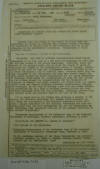
|
30. February 11, 1933.
G-2 Report on "Manifestos of
Sandino After His Signing of the
Peace Treaty with President
Sacasa," Naval Attaché,
Tegucigalpa, p. 1.
"Shortly after his return to San
Rafael del Norte from the
conference in Managua on
February 2nd, General Sandino
forwarded two manifestos to
Managua; one to the newspapers
and one to his delegates at the
preliminary conference.
Translation of these articles
follows: ¶ “MESSAGE OF GENERAL
SANDINO TO THE NEWSPAPERS: ¶
‘Brothers: Our work of national
fraternization would remain
incomplete if at this hour of a
new life for Nicaragua we left
some of the live forces of the
nation scattered. Therefore,
since the second of the current
month, day on which the treaty
of peace of Nicaragua was signed
in the Presidential Palace of
Managua, terminating on our part
for ever the differences between
brothers to see in every
Nicaraguan a bit of national
love. Everyone knows that the
army commanded by the
undersigned has with good result
fought for seven years against
the armed intervention and the
party tendencies of Nicaragua
which aided the intervention and
thus for this reason in its
notices placed the
responsibility for the tragedies
of Nicaragua on General Jose
Maria Moncada, Don Adolfo Diaz,
Dr. Carlos Cuadra Pasos and
General Emiliano Chamorro;
nevertheless, happily for
Nicaragua, by the work of
destiny a new life has arisen
embracing fraternity and as a
sign of national reconciliation
the four brothers mentioned
above are also included.
Nicaragua sweetly begs for
greater union and national love
on the part of her sons. ¶ ‘It
is hoped that in the future when
electing a mandate of the
country all national tendencies
will launch their candidate so
that among the candidates of the
distinct tendencies there will
arise a single candidate for the
National Government who upon
assuming power will not have
adversaries and all the
Nicaraguans as one individual
will cooperate with him in the
general bettering of the beloved
fatherland.’ ¶ ‘Temporary
Headquarters of the Defensive
Army of the National Soverignty
[Sovereignty] of Nicaragua,
Segovia, Nicaragua, February 5,
1933. ¶ ‘FATHERLAND AND LIBERTY
--- Agusto C. Sandino.’” ¶ “THE
MESSAGE TO HIS DELEGATES: ¶
‘Temporary Headquarters of the
Defensive Army of the National
Soverignty [Sovereignty] of
Nicaragua,- Guadalupe Farm,
February 4, 1933. ¶ To the
gentlemen members of the Peace
Commission: Don Salvador
Calderon Ramirez, Dr. Pedro J.
Zepeda, General Horacio
Portocarrero and Dr. Escolastico
Lara: ¶ (Continued on PAGE
TWO--- . . . "
|
|
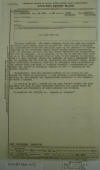
|
31. February 11, 1933.
G-2 Report on "Manifestos of
Sandino After His Signing of the
Peace Treaty with President
Sacasa," Naval Attaché,
Tegucigalpa, p. 2.
" . . . ‘My dear brothers: The
armed struggle which our Army
has carried on during seven
cruel years to sustain the ideal
of our soverignty [sovereignty]
and independence which was
enfringed [infringed] upon by
the presence of foreign soldiers
in our territory during twenty
broken years interferring
[interfering] with our internal
affairs, has been ended
honorably and satisfactorily for
the country. It is pleasing to
me and to you who have stood by
me at the solemn instant when my
trip to the capital to converse
with Dr. Juan Bautista Sacasa
was decided, to whom I expounded
clearly the problem and who when
he understood our patriotic
ideal, apart from individual
interests, knew how to interpret
them by celebrating the treaty
which you know, a historic
document, transcendental and
closes the period of struggle,
opening an era of tranquility
and public welfare. ¶
‘Opportunely, when the
reconcentration of our forces at
San Rafael del Norte is
completed, I will publish a
manifestation containing all the
details and explanations
pertinent to the document to
which I allude. ¶ ‘In writing to
you I render you my most fervent
thanks for your efficacy the
same as your patriotic services
and always count on the esteem
and friendship of your partisan
and brother. ¶ ‘FATHERLAND AND
LIBERTY --- Augusto C. Sandino’"
|
|
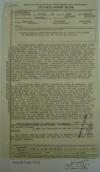
|
32. February 10, 1933.
G-2 Report "Pacification of
Nicaragua — Reception of Sandino
in Managua by President Sacasa
and the Public In General,"
Naval Attaché, Tegucigalpa, p. 1.
"The first steps toward the
pacification of Nicaragua were
taken by the parents of Sandino
who, around the middle of the
month of January 1933, came to
Managua and arranged a
conference with Sofonías
Salvatierra, Minister of
Agriculture in Sacasa’s cabinet.
The outcome of this conference
was a trip made by Mr.
Salvatierra accompanied by the
parents of Sandino to San Rafael
del Norte and thence to the
bandit encampment. Here a
conference was held with Sandino
in person in which both
Salvatierra and Sandino signed
an armistice for a period of
fifteen days. At the same time
Sandino named the ones whom he
chose as his delegates,
forwarding his instructions to
them, to meet three delegates of
the government in Managua to
arrange the preliminaries for
treaty between Sandino’s forces
and the government for the
pacification of Nicaragua. As a
result of this conference the
three delegates of the
government proceeded to San
Rafael del Norte and conferred
with Sandino in person,
expounding to him the terms
Sacasa offered. Sandino accepted
and made his plans to proceed in
person to Managua to complete
the treaty with President
Sacasa. ¶ On 2 February 1933
Sandino arrived by plane in
Managua. When he was received by
President Sacasa, Sandino
addressed him in the following
manner: “I, Doctor Sacasa, come
now to make peace. While a
single tendon of the foreigners
clung to my land, without other
right than the gross right of
the strong over the weak, I
clung to the rebel rifle with a
handful of valiant soldiers in
the crude mountains of Segovia.
But today, as no foreign flag
blemishes our sky, I come to you
with my heart in my hands, full
of faith, to tell you that we,
the rebels of the autonomist
army, have a great love for all
that pertains to Nicaragua, and
for her liberty we have fought,
suffered hunger and great
hardships in the mountains of
the north--That an unbreakable
faith has maintained us always
virile before the army of the
foreigners, and now that we have
fulfilled our mission of destiny
pointed out to us by the finger
of God of all nations, we want
peace. For us, in Nicaragua
there are neither Liberals nor
Conservatives, only Nicaraguans,
free citizens of our beloved
fatherland, desirous of living a
life of peace and labor”. ¶
After a brief pause he continued
as follows: “Here I am. I come
to sign an unconditional peace.
For ourselves we ask nothing and
accept nothing, only for
Nicaragua we ask and demand
Peace and Liberty. ¶ Dr. Sacasa
made no reply other than to
embrace him and assured him that
without difficulty, if there was
a will, the matter could be
happily closed. . . . "
|
|
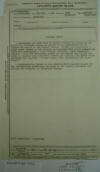
|
33. February 10, 1933.
G-2 Report "Pacification of
Nicaragua — Reception of Sandino
in Managua by President Sacasa
and the Public In General,"
Naval Attaché, Tegucigalpa, p. 2.
" . . . A conference was then
held in which a treaty was drawn
up and signed by President
Sacasa on behalf of the
government and by Sandino on
behalf of the bandit forces.
During the conference a large
crowd formed in the streets and
shouted with great enthusiasm:
“Live the Patriotism”, “Live
General Sandino”, “Live
President Sacasa”. When the
conference ended and the treaty
was signed the first to embrace
were President Sacasa and
Sandino. The crowd waxed
hilarious and shouted: “Peace,
Peace, Live Nicaragua, Let Peace
Reign”: ¶ A manifestation formed
in the streets which paraded
headed by the Presidential guard
band and many of the leading
citizens including the daughter
of President Sacasa."
|
|
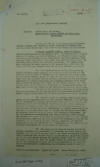
|
34. February 8, 1933.
G-2 Report on Peace Treaty
Between Sandino and the
Nicaraguan Government, Major A.
R. Harris, Military Attaché, San
José, p. 1.
"G-2 Report. ¶ 2,700 ¶ NICARAGUA
(Population & Social) ¶ Subject:
Public Order and Safety. ¶ Peace
Treaty between Sandino and
Nicaraguan Government. ¶ On
February 7th the Costa Rican
press published, without
comment, the “Treaty of Peace”
concluded by Sandino with the
Nicaraguan Government. The terms
of the treaty are as follows: ¶
“Salvador Calderón Ramírez,
Pedro J. Zepeda, Horacio
Portocarrero and Escolástico
Lara, representatives of General
Augusto C. Sandino and David
Stadthagen and Crisanto Sacasa,
representatives respectively of
the conservative and
liberal-nationalist parties,
fully convinced of the urgent
necessity of peace within the
republic, have reached the
following agreement. The signers
have been motivated in their
actions by the sincere love with
which the future of Nicaragua
inspires them and by high
sentiments of honor. ¶ “1. The
representatives of General
Augusto C. Sandino declare,
above all, that the campaign of
the latter and his army has been
in favor of liberty for the
country; and consequently, at
the present moment, desire to
state in the name of the one
they represent, his complete
lack of personal interest and
his irrevocable resolution of
neither requesting nor accepting
anything which might detract
from the motives and causes of
his public conduct. He wishes
therefore, to lay down as a
principle, or unchangeable
basis, the fact that he does not
aspire to any lucrative or
material advantages. ¶ “In view
of the foregoing statement of
disinterest, the representatives
of the conservative and
nationalist-liberal party render
homage to the noble and
patriotic attitude of General
Sandino. ¶ “2. General August C.
Sandino, through his delegates
and the representatives of both
parties declares: that in view
of the withdrawal of foreign
forces from the national
territory, undoubtedly an era of
fundamental renovation in our
public existence is about to
commence; that this event is of
vital transcendency in our
national destiny and that,
disciplined by painful
experiences, he considers it an
imperative duty to fortify the
collective sentiment of autonomy
which moves Nicaraguans with
unanimous enthusiasm. And for
the purpose of accentuating this
noble tendency, those signing
the present pact agree to
outline as a capital point in
their political programs,
respect of the constitution and
fundamental laws of the
republic; and to maintain by all
rational, adequate and judicial
means, and in all its plenitude
the resplendence of the
political and economic
sovereignty and independence of
Nicaragua. ¶ “3. The delegates
of General Sandino and of the
parties recognize the
convenience of cementing the
peace within the republic in a
practical manner, through the
means of fruitful dedication to
labor of the men who rallied
around General Augusto C.
Sandino and in the same manner
through the gradual laying down
of their arms. In order to
attain for sure the normal
course of existence of these men
in the activities of labor under
the protection of the laws and
of the constitutional
authorities, the following
measures will be adopted: ¶
From: M. A. Costa Rica ¶ Report
No. 1,942 ¶ Date: February 8,
1933. . . . "
|
|
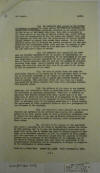
|
35. February 8, 1933.
G-2 Report on Peace Treaty
Between Sandino and the
Nicaraguan Government, Major A.
R. Harris, Military Attaché, San
José, p. 2.
" . . . G-2 Report. ¶ 2,700. ¶
“(a) The Executive will present
to the National Congress a
proposal for ample amnesty for
political offenses, and common
ones in connection therewith,
committed in the period between
the 4th of May of 1927 until
this date. This will be extended
to all those members of the army
of General Sandino who, within
fifteen days from the
promulgation of the said decree
may deposit their arms and
likewise all those who with the
authorization of General Sandino
himself promise to deposit them
within three months. In the
aforementioned group will be
included one hundred persons of
the army mentioned who may
temporarily retain their arms
for the purpose of policing the
zone of public lands on which
all those who belonged to the
said army have a right to
settle. ¶ “(b) The Executive
will appoint as his delegate don
Sofonías Salvatierra for the
purpose of representing the
administrative and military
authorities of the Government in
the western departments and more
especially the zone set apart
for the members of General
Sandino’s army and also for the
purpose of gradually receiving
their arms. General Sandino will
turn over to him within twenty
days from this date not less
than 25 per cent of all classes
of arms in possession of his
army. ¶ “(c) The zone of public
lands set aside for cultivation
referred to in insert (a) of
this agreement shall be laid out
in sufficient extension in the
valley of the Coco or Segovia
river or in such region as may
be agreed upon between Congress
and General Sandino. This zone
must remain not less than ten
leagues (approximately 30 miles)
distant from towns where
municipal authorities actually
exist. ¶ “(d) The officers of
the guard of one hundred armed
men, the retention of which is
permitted, will be appointed by
the Government as emergency
auxiliaries. They will be
selected in agreement with
General Sandino from among
capable members of his army;
but, if after one year from date
of promulgation of the amnesty
decree it be convenient in the
judgement [judgment] of the
Government to maintain the
aforesaid guard of one hundred
armed men or a lesser number,
the appointment of their
respective officers will be a
prerogative of the President of
the Republic. ¶ “(e) The
Government shall maintain in the
entire republic and especially
in the northern departments, for
a minimum period of one year,
public works in which
preferential employment will be
granted to such members of the
army of General Sandino as may
request it and are willing to
abide by ordinary rules
established for these works. ¶
“4. The fact of the signing of
this agreement will cause a
cessation of all forms of
hostilities between the forces
of both parties, that is to say,
the Constitutional Government
presided over by Dr. Juan B.
Sacasa and those of General
Augusto C. Sandino, as an
immediate guarantee of life and
property of Nicaraguans. Once
this agreement is definitely
signed with the approval of
General Sandino and by
acceptance by the President of
the Republic, all of the force
of General Sandino will come
under the protection of the
constitutional authorities and
in consequence is obliged to
cooperate in the maintenance of
public order. ¶ From: M. A.
Costa Rica ¶ Report No. 1,942 ¶
Date: February 8, 1933. . . . "
|
|
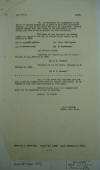
|
36. February 8, 1933.
G-2 Report on Peace Treaty
Between Sandino and the
Nicaraguan Government, Major A.
R. Harris, Military Attaché, San
José, p. 3.
" . . . G-2 Report. ¶ 2,700. ¶
“5. To facilitate the
disarmament of the forces of
General Sandino and in order to
give them provisional shelter,
the town of San Rafael del Norte
is designated. General Sandino
himself will take charge of the
maintenance of order during such
time as the Government may deem
convenient. ¶ “”In faith of this
agreement two similar copies are
signed in the city of Managua on
the second day of February of
1933. ¶ (s) S. Calderón Ramírez.
¶ (s) Pedro José Zepeda. ¶ (s)
H. Portocarrero. ¶ (s) D.
Stadthagen. ¶ (s) Crisanto
Sacasa. ¶ “Approved and ratified
in all its parts. Managua, D.
N., February 2, 1933. ¶ (s) A.
C. Sandino. ¶ “Accepted in all
its parts. Managua, D. N.
February 2, 1933. ¶ (s) J. B.
Sacasa.” ¶ The next few weeks
will disclose just how much
authority Sandino holds over his
various sub-chiefs. It is
claimed by some that this
authority is very small. ¶
Further notices state that
Sandino will leave for the
Argentine as soon as possible. ¶
Source: As stated. ¶ A. R.
Harris, ¶ Major, G.S., M. A. ¶
From: M. A. Costa Rica ¶ Report
No. 1,942 ¶ Date: February 8,
1933."
|
|
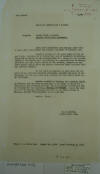
|
37. February 3, 1933.
G-2 Report, "Sandino Signs Peace
Agreement," Major A. R. Harris,
Military Attaché, San José.
"G-2 Report. ¶ 2,700 ¶ NICARAGUA
(Population & Social) ¶ Subject:
Public Order & Safety. ¶ Sandino
Signs Peace Agreement. ¶ Brief
news dispatches from Managua
state that a peace pact with
Sandino was finally concluded on
February 1st. ¶ Complete details
of the peace pact are not as yet
known. However, it is stated
that one of Sandino’s
conditions, which was accepted,
is the incorporation of a change
in the constitution to the
effect that “no attorney or
representative of foreign
companies can hold office either
in the cabinet, congress or any
other public office where his
private interests might conflict
with his official duties.” ¶ If
the above is correct, it will
mean the removal of Dr. Salvador
Guerrero Montalván, Sacasa’s
Minister of the Treasury, who
for years has been attorney for
the United Fruit Co. in
Nicaragua. ¶ Sandino arrived in
Managua, via airplane (TACA) on
February 1st and went
immediately to the Campo de
Marte for a conference with
President Sacasa. He left
Managua on February 2nd by
airplane for the Segovias. About
200 members of the Guardia
Nacional, who were at the flying
field in Managua, shouted “Viva
Sandino”, as he took off. ¶
Source: Press. ¶ A. R. Harris, ¶
Major, G.S., M.A. ¶ From: M. A.
Costa Rica ¶ Report No. 1,034 ¶
Date: February 3, 1933."
|
|
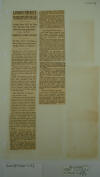
|
38. February 3, 1933.
Press Clipping.
"SANDINO
EMERGES TO NEGOTIATE PEACE ¶ A
Rebel Since 1927, He Flies Into
Managua and Confers With
Nicaraguan President. ¶ EMBRACES
GUARD OFFICER ¶ “No More War,”
He Says—Sends Regards to
Americans, but Bars Them as
“Bosses.” ¶ Copyright,
1933, by The Associated Press. ¶
MANAGUA, Feb. 2.—General Augusto
Sandino, with whose forces the
Nicaraguan Government and the
United States Marines have
engaged in many combats, arrived
at the Presidential palace today
to discuss terms under which he
would make peace with the
country. ¶ Dressed picturesquely
in gabardine trousers, a blue
jacket and high boots, he wore a
red handkerchief around his neck
and carried an automatic pistol
and field glasses. ¶ Some time
after he had been closeted in
the Presidential mansion with
President Juan B. Sacasa,
members of his commission and
high government officials,
General Sandino issued a
statement in which he sent his
regards to the American people
and said it was the duty of the
Nicaraguans to establish peace.
¶ Bars Americans as
“Bosses.” ¶ The
statement read: ¶ Why discuss
the basis of peace? It is our
duty as Nicaraguans to establish
it as we are all brothers. I
have nothing against North
Americans personally; let them
come and work here. However, for
them to come as our bosses we
should not accept. I send my
regards to the American people.
¶ The General came here by plane
direct from his mountain
headquarters in the northern
part of the country accompanied
by three members of a peace
commission he had authorized
recently to carry on preliminary
negotiations. The members of the
commission were Salvador Ramirez
Calderon, Horacio Portocarrero
and Dr. Pedro Jose Zepeda. ¶
General Sandino’s father, who
was said to have participated in
the conference several days ago,
at which a protocol setting out
the terms under which the
General would accept peace had
been drawn up, also was in the
plane, which was piloted by
Julio Zinser, a Mexican. ¶ The
General was met at the airport
by a National Guard officer who
is in charge of the aviation
field. The officer greeted him
and offered to shake hands.
General Sandino replied by
embracing him and saying: ¶ “Let
us embrace, we are brothers. I
come with peace. We will have no
more war. We are free and
independent.” ¶ Then he turned
and greeted National Guardsmen
who were on the field saying,
“Guardias, we are all brothers.”
He was then taken by automobile
to the Presidential Palace,
stopping off at his parents’
home where he greeted his
mother. ¶ The consensus here was
that the chances for peace were
good, but details of any
arrangement that might be made
were not known. ¶ An
Insurgent Since 1927. ¶
Since 1927 Cesar Augusto Sandino
waged intermittent warfare
against the United States
Marines and the Nicaraguan
National Guard. ¶ Born about
thirty-eight years ago near
Managua of middle-class folk,
Sandino moved to Mexico as a boy
with his family and went to
school there. Unverified reports
say that he served in the army
of Pancho Villa; if so, then it
was from Villa that he learned
the elusive surprise tactics
that have been so provoking to
his foes. ¶ Returning to
Nicaragua, he worked for a time
as a clerk and timekeeper in an
American-owned gold mine. When
the mine was shut down, no
longer able to operate at a
profit, Sandino joined the
liberal forces in the
revolution. In one engagement he
stood his ground while his
comrades fled, whereupon he was
embraced by General Moncado
[Moncada] and advanced on the
spot from the rank of private to
general. ¶ In 1927 Henry L.
Stimson arrived in Nicaragua as
peace-maker. ¶ But, despite the
agreement negotiated by Mr.
Stimson, General Sanidon
[Sandino] declined to lay down
his arms and began his prolonged
warfare. ¶ His stronghold was in
the mountains of Nueva Segovia,
whence he breathed defiance in
violent manifestoes and in
somewhat personal letters to
Marine officers. He declared,
time after time, that while he
was willing to make peace, he
would not do so while United
States Marines remained in
Nicaragua. ¶ Source of
Funds a Mystery. ¶ The
forces of General Sandino have
been variously estimated. Some
put the number at 500, others as
high as 5,000. The smaller
figures probably is [are] nearer
the true number. Where and how
General Sandino has managed to
raise the funds to keep his
force together, still remains a
mystery."
|
|
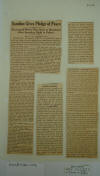
|
39. February 3-4,
1933. Press Clippings.
"Sandino
Gives Pledge of Peace ¶
Nicaraguan Rebel Flies Back to
Mountains After Spending Night
in Palace. ¶ Copyright,
1933, by Associated Press. ¶
MANAGUA, Nicaragua, Feb. 3.—A
promise of peace after six years
of revolt against the
American-advised governments of
Nicaragua was left behind today
by Gen. Augusto Sandino as he
headed back to the mountain
headquarters of his army. ¶ The
importance of his message was
almost forgotten in the
excitement caused by the
sensational manner in which he
delivered it. His visit was a
complete surprise. ¶ A plane
from his northern jungle retreat
arrived here yesterday with the
commander, his father and three
political allies. With an
automatic pistol swinging on his
hip, he walked into the
Presidential Palace, sat down
with President Juan Bautista
Sacasa and made his pledge of
peace. ¶ Then the man who had
hunted and been hunted by
Nicaraguan native soldiers and
American Marines since 1926
enjoyed the luxury, particularly
for him, of a night’s sleep in
the Palace. ¶ “Peace is now a
fact. Nicaragua entered a new
era when the last United States
Marines departed from our soil,”
he told this correspondent after
his conference with the
President and other Government
leaders. ¶ Believe He
Will Keep Pledge. ¶ The
General had kept one pledge and
Government leaders were of the
opinion that he would keep this
on. He had often said that he
would persist in his sanguinary
struggle until the last United
States marine had departed from
Nicaragua. The United States
marines, who for most of
nineteen years had been
stationed in Nicaragua,
completed evacuation of the
country within two days after
the inauguration of President
Sacasa, January 1. ¶ Only a few
days before the last marine
left, more than twenty soldiers
were reported slain in an
engagement between native guards
and Sandinistas. A few isolated
engagements since caused
considerable doubt whether peace
was at hand. ¶ The terms of the
peace settlement were not made
public. ¶ “I ask for nothing
personally,” the General said. ¶
A protocol was brought here by
Sandinista emissaries less than
two weeks ago, outlining
conditions for a truce to “leave
the hands of my (Sandino’s)
representatives free to make
peace in the most honorable was
for myself, my soldiers and the
Nicaraguan Government.” There
was no thought of “surrender,”
said his men. ¶ The General said
he had control of all his
officers and man and did not
expect any further trouble.
After his return by plane today
he was to order them to lay down
their arms. ¶ “In case some
unforeseen objection is raised
by my soldiers situated far from
central control, and they
continue the rebellion, I have
placed myself at the orders of
President Sacasa and will aid
him in forcing them to follow my
example,” he asserted. He
indicated he considered his army
the best “disciplined in the
world.” ¶ “I have nothing
against North Americans
personally; let them come and
work here. However, we should
not accept them coming as our
bosses. I send my regards to the
American people,” Sandino said
in a statement issued during the
course of the peace conference.
¶ SANDINO SUBMITS.
¶ General SANDINO, whether he be
regarded as a bandit, or as a
patriot according to his lights,
must have credit for going to
Managua as a peacemaker and as a
supporter of President SACASA of
Nicaragua. He had doubtless been
assured that his draft of terms,
negotiated by the Nicaraguan
Minister of Agriculture, would
have SACASA’S approval. At his
inauguration the President
announced that he would make a
peaceable settlement with the
rebel for five years if
practicable, but would use force
to suppress him if that should
be necessary. In reporting the
pacification of Nicaragua, the
President states that he was
“aided by the good-will of
General AGUSTINO CESAR SANDINO
and his delegates.” This may
sound magnanimous but may be
good diplomacy. SANDINO is a
hero to Nicaraguans of his
class. Whether he was sincere
when he said that he would lay
down his arms after the last
American Marine left the
country, or realized that it
would be a losing fight to
resist a Government elected by
the people and defended by a
well-trained National Guard, is
not of much consequence. He is
accepted by the new Government
as a good citizen and has only
to behave himself to receive
liberal treatment. ¶ President
HOOVER announced long ago that
our Marines would be withdrawn
as soon as a stable Government
was established. It was his
policy to give to American
citizens the protection allowed
by international law, without
trenching on the rights of the
Nicaraguan people. From time to
time battalions of Marines were
brought back, enough being left
to supervise elections.
Meanwhile a native National
Guard was officered and trained
as a police body. It was the
carrying out of Mr. HOOVER’S
policy that stabilized Nicaragua
and prepared the way for the
submission of SANDINO. He now
shows no ill will toward
Americans. If Nicaragua is on
the eve of enduring peace, it is
largely due to the attitude of
the American Government and its
adherence to a plan that had the
approval of Latin America. ¶
ANOTHER “RETIREMENT”
¶ We could wax a little
more enthusiastic over the
decision of Augustino Sandino to
be a good boy if he had ever
succeeded in staying reformed in
the past. But the sad fact is
that no matter how often Sandino
has retired from the business of
guerrilla warfare he has come
back just as often. Like Pancho
Villa, with whom he is said to
have served at one time, he has
been a sort of perpetual bandit,
whose longings always draw him
back into the game no matter how
he may strive to resist
temptation. ¶ The one thing
which seems to give the
retirement he announced at
Managua on Thursday a greater
promise of permanence than such
announcements have carried
heretofore is the circumstance
that the United States has
actually withdrawn all of its
marines from Nicaraguan soil.
Although Sandino has been
attacking his own countrymen as
often as he has attacked our
marines, he has always professed
to be fighting to free
Nicaraguan soil from Yankee
domination. Now that the soil
has been cleared as he desired,
the rebel chieftain comes in and
makes his peace with the
Government that American troops
helped support. Perhaps a
retirement from the profession
of banditry arranged under such
conditions will assume an
enduring quality that has been
lacking in the past. ¶ The
change would be to everybody’s
advantage. Sandino’s eruptions
have lost a good deal of their
original potency, if indeed were
ever quite as serious as our
expeditionary commanders sought
to make them. But even though
they have declined in power,
they remained a potential threat
to the peace and security of his
country. They also provided
American jingoes a potential
invitation to prolonged
intervention in the affairs of a
country which in good conscience
we ought to have left alone.
Nicaragua and this nation alike
may breathe more freely if this
particular thorn in the flesh is
finally withdrawn."
|
|
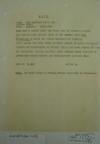
|
40. ca.
December 1931. Telegram, Nicaraguan National Guard
Detachment to OpNav.
"Native
Lieuts. Silva and Valle with La
Trinidad patrol had contact with
bandits group of 100 jefe Juan
Altamirano at Cerro Las Tables
northeast of Trinidad.
Fight lasted two hours until
darkness closed in bandit
casualties unknown but
indications of several killed
and many wounded to Guardia
casualties Guardia captured 40
animals small quantity jof
ammunition correspondence and
misc. articles. Note:
15 miles south of Esteli, Marine
Corps Map of Nicaragua."
|
|
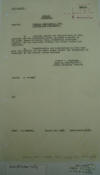
|
41.
January 10, 1933. G-2
Translation of local press on
Sandino & Nicaragua, Capt.
Robert E. Cummings, Acting
Military Attaché, Mexico City, p. 1.
"G-2
Report ¶ 3850-a ¶ MEXICO ¶
POLITICAL ¶ SUBJECT: Foreign
Relations,- Etc. ¶ SANDINO and
Nicaragua. ¶ 1. Attached hereto
are translations of four
articles and two editorials
which appeared recently in the
local press of Mexico City,
concerning Nicaragua, Sandino,
and the relations between the
United States and Nicaragua. ¶
2. The editorials are
interesting in that they give
the attitude of the local press
toward the Occupation of
Nicaragua by the United States
Marines. ¶ Robert E. Cummings, ¶
Captain, Infantry (DOL) ¶ Acting
Military Attaché. ¶ Source: As
stated/ ¶ C/p ¶ From:
M.A.Mexico. ¶ Report No. 4359. ¶
Date: Jan. 10, 1933. . . . "
|
|
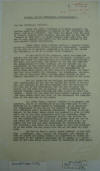
|
42.
January 10, 1933. G-2
Translation of local press on
Sandino & Nicaragua, Capt.
Robert E. Cummings, Acting
Military Attaché, Mexico City, p. 2:
Horacio Espinosa, "Sandino and
His Detractors (Deturpadores)",
Universal Gráfico, p.
2.
"
. . . SANDINO AND HIS
DETRACTORS (“Deturpadores”)
¶ For the “UNIVERSAL
GRÁFICO”. ¶ Under the title
“Problems of Spanish America”,
Sr. Enrique Lumen has commenced
to publish in the “Universal
Gráfico[“] a series of articles.
The first one deals with the
case of General Augusto Cesar
Sandino, the man who, in his
role of “General of Free Men”,
as Henry Barbuse would call him,
has set up –and perhaps has
solved it- the great problem of
his race against Yankee
imperialism. ¶ Señor Lumen calls
General Sandino a “puppet”
manipulated by individuals
without patriotic conscience,
“ignorant of the role he is
playing, controlled by some of
his agents and advisers,- as he
is a rustic field laborer”. ¶ To
the world of the Americas, which
has seen how Bolivar was
attacked and how he died
abandoned, saddened, and poor;
how Sucre was treacherously and
cowardly assassinated,- the
best, the most just, the purest
of the men who achieved the
independence of South America;
and how Lincoln was
assassinated, he who emancipated
the slaves; to the American
world who knows this, and more,
as to the ingratitudes of which
these truly great men have been
the victims, and knows the fate
which befell the Socrates, the
Columbuses, etc. etc., will not
be surprised that a writer comes
forward to deal similar
treatment to one of the
authentic heroes of our race. ¶
Yet Sr. Lumen had no dealings
personally with General Sandino,
whom he did not see during his
visit to Nicaragua, but probably
he did have dealings with the
traitors to his race and to his
fatherland, who are men of power
and wealth and who know how to
impress, as their perverse
interests dictate, some
visitors, and even a part of
their own people. These are the
ones who have called Sandino a
bandit, and made others call him
such, to the amazement and
indignation of the free men of
the world. ¶ No, Señor Lumen,
General Sandino is no puppet,
nor ignorant, and he is
controlled by no one; very much
to the contrary, and he is
almost immune to influence, as
he possesses the temperament of
the men in the history of
humanity who have reflected
great spiritual rebellion.
Neither is he ignorant, in the
broad sense which you pretend to
give to this word; and if you
were acquainted with his
archives, where there are many
important documents drafted and
written in his own handwriting,
and which you or anyone else can
see in the house 157 Calle
Salvador Díaz Mirón, in this
city,- no matter how far you had
been influenced by information
you had received,- you would not
have dared to call him ignorant,
as no one would who had dealt
with him or who knew his real
work. ¶ Nor has he been “a
rustic field laborer” as you
call him: a mechanic, yes,-
expert and diligent, and working
as such he earned his living
before the maneuvers of Yankee
imperialism in his country
compelled him to emerge as a
prototype of our race which
should never be dominated by
foreigners. . . . "
|
|
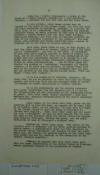
|
43.
January 10, 1933. G-2
Translation of local press on
Sandino & Nicaragua, Capt.
Robert E. Cummings, Acting
Military Attaché, Mexico City, p. 3:
Horacio Espinosa, "Sandino and
His Detractors (Deturpadores)",
Universal Gráfico,
p. 3.
"
. . . Aesop was a slave;
Shakespeare, a groom at the
doors of a London theatre;
Lincoln was a rail-splitter;
Franklin, a printer; but all
this done not dim their glory. ¶
In his article, Señor Lumen
states that he “looked at the
facts in the proper light, and
that the opinion which prevailed
in Guatemala, Honduras, El
Salvador and Costa Rica, as to
‘Sandinismo’ fully reflected the
reality. Countries which, by
being adjacent or very near to
Nicaragua, maintain a closer
contact with her than other
nations,- Mexico, for example,-
had been able to properly
appraise the work of the
so-called ‘patriots of the
Segovias’, the army which, from
patriots, had become converted
into a menace to progress and to
the cause of Spanish America.” ¶
What Señor Lumen tries to say,
in this jargon, is that the
other Republics of Central
America have a bad opinion of
“Sandinismo”. And that is not
true. In Guatemala we have seen
great popular parades in favor
of General Sandino, and we can
state that such was the
enthusiasm of the masses that
the Government, fearing to be
placed in a bad light with the
United States Government,
prohibited a repetition of these
manifestations. And if Señor
Lumen had studied the problem of
“Sandinismo” throughout all
Central America, as he would
have us believe, he surely would
have seen in the streets of the
City of Guatemala what the
people had written on the iron
electric-light posts, “Viva San
Digno” (“Long Live Sandino”). ¶
As to the people of El Salvador,
Honduras, and Costa Rica, we are
in position to state that they
are virile people, and that they
have not the weakened blood of
slaves, to conform to Yankee
imperialism in Central America.
¶ It is the governments and the
created interests with which
“Sandinismo” has not squared;
and if it was in the
drawing-rooms and the ante-rooms
of the “poderosos” (those in
power), that Señor Lumen “became
impressed”, then that explains
his singular interpretation of
the social phenomena of
“Sandinismo”. ¶ Señor Lumen, if
the truth were told, gives the
impression that he does not
know, or appears not to know,
what he is talking about, in his
article. He says that the right
of the United States to open the
canal in Nicaragua is “shared
with England”. Where does Señor
Lumen get his basis for such a
statement? By this we must
believe that he does not know of
the treaties which the United
States has imposed upon helpless
Nicaragua, through its power,
and the moral corruption of some
of Nicaragua’s disloyal sons. ¶
Further on, Señor Lumen says:
“The rebels of the Segovias made
it necessary for the North
American marines to remain
there,- a justification which
was very important to the United
States Government, not because
of what the world would say, but
because the general opinion of
the North American people was,
and is, contrary to the
occupation of the Central
American republic.” ¶ It would
be deduced from what Señor Lumen
says, that the armed
intervention of the United
States in Nicaragua became
necessary because of the
appearance of Sandino. . . . "
|
|
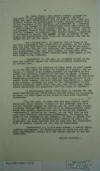
|
44.
January 10, 1933. G-2
Translation of local press on
Sandino & Nicaragua, Capt.
Robert E. Cummings, Acting
Military Attaché, Mexico City, p. 4:
Horacio Espinosa, "Sandino and
His Detractors (Deturpadores)",
Universal Gráfico, p.
4.
"
. . . No, Señor Lumen,- long
before Sandino appeared on the
scene of our struggles against
the Yankee – in 1912 – there was
armed intervention; also in 1926
and 1927, when the marines,
rifles and machine-guns in band,
imposed Adolfo Díaz as the
President of the Republic, and
prevented by a thousand methods,
the triumph of our institutions
which were upheld by a great
majority of the Nicaraguan
people. In General Sandino the
national dignity found refuge,-
the cry of a race, when in 1927
Mr. Stimson, in agreement with
General Moncada, compelled, or
pretended to compel, the latter
to deliver up the rifles and
machine-guns with which the
Nicaraguan army had defended its
law and its right. ¶ The
attitude, then, of Sandino, and
of those of us who have
accompanied him, physically or
morally, in his struggle, has
been that which is assumed by
free men of the soil,- that
which the English, the Mexicans,
the French, the Italians, the
Argentinians, etc. etc. will
assume, if they find their soil
invaded and their rights
trampled upon, with might as the
only right of the offender. ¶
“Sandinismo” is the epic of a
handful of men of one race who
manfully oppose the imperialism,
merely biological, of another
race. ¶ But where the tendency
of Señor Lumen is most marked is
in the part where he refers to
Sandino as a puppet, and
ignorant,- “a rustic field
laborer, managed and exploited
by his agents and advisers,
ignorant of the role he plays,
directed by some of his agents
and advisers,- men of culture
and political shrewdness,
(qualities which he does not
possess because he is a rustic
field laborer) who have enriched
themselves in a suspicious
manner;- advisers who send to
the ‘guerrillero’ of the Segovia
mountains funds which they say
they obtain from Continental
multitudes who sympathize with
the cause of liberty”. ¶ We
courteously invite Señor Lumen
to specify who are these
individuals, and which funds,
and how much,- as we suppose he
knows all this since he has
dared to make such startling
statements. ¶ For our part, we
know that the only general
representatives which General
Sandino and his glorious army
have had, are Froylán Turcios
the writer, and Dr. José Pedro
Zepeda. Regarding Turcios, we
know that he is in Europe,
without other means than monthly
remittances sent to him by the
Honduran Government. Regarding
Dr. Zepeda, we are told that he
has made great personal
sacrifices, economically, to
support the cause of the
autonomy of his country,- to
such an extent that he is today
in reduced circumstances,
whereas he owned city properties
and bank deposits when he took
over the representation of
General Sandino and the Army of
Liberation. ¶ “Sandinismo” is,
by its very nature, a social
inter-American phenomenon, the
transcendence of which has not
yet been comprehended, except by
a few select spirits of our own
Continent. ¶ HORACIO ESPINOSA. .
. . "
|
|
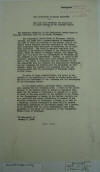
|
45.
January 10, 1933.
G-2 Translation of local press
on Sandino & Nicaragua, Capt.
Robert E. Cummings, Acting
Military Attaché, Mexico City,
p. 5:
"The Nicaraguans in Mexico
Delighted - Now They Will
Celebrate the Evacuation of
Their Country By the American
Forces,"
El Universal,
Jan. 3, 1933.
"
. . . Translation ¶ THE
NICARAGUANS IN MEXICO DELIGHTED
¶ How they will celebrate the
evacuation of their country by
the American forces. ¶ The
Executive Committee of the
Independent Reform Party of
Nicaragua yesterday made the
following statement: ¶ The
Independent Reform Party of
Nicaragua, Mexican Section, has
today held a solemn meeting to
commemorate the date on which
the soldiers of the regular army
of the United States departed
from the territory of the
Nicaraguan fatherland after six
years of occupation and of
military activities. The Party
in question considers this
occurance [occurrence] as an
effective triumph of the
Liberating Army which, under the
orders of General Sandino, has
fought for more than five years
for the independence of
Nicaragua and the recovery of
its sovereignty. However, in
spite of the patriotic
enthusiasm which this event
awakens in the element of the
Party, it considers that the
material act of the evacuation
does not conclude the
imperialistic influence and the
vigilance and control over the
government of that country,
since the economic and financial
ties and the treaties which harm
the sovereignth [sovereignty] of
Nicaragua remain in full force.
¶ In spite of these
considerations, the event is
important as the beginning of a
series of events which will end
with the attainment of the
autonomy and the sovereignty of
the Nicaraguan nation. ¶ At the
solemn meeting mentioned above,
resolutions were adopted for the
following act: a visit of the
entire meeting to the Mexican
press to inform it regarding
this event and the making of
statements to explain it; a
guard of honor of the same
meeting at the monument of the
Heroes of the Independence in
homage to the Mexican patriots
and as a patriotic and racial
celebration on account of the
military evacuation of
Nicaragua; a dinner to be held
at a centrally located
restaurant to which will be
invited outstanding personages
of the Mexican press; and a
lecture to be delivered over the
radio interpreting this event
according to the ideas and
tendencies of the Independent
Reform Party of Nicaragua. ¶ “El
Universal” of January 3, 1933. .
. . "
|
|
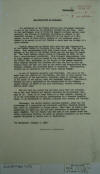
|
46.
January 10, 1933. G-2
Translation of local press on
Sandino & Nicaragua, Capt.
Robert E. Cummings, Acting
Military Attaché, Mexico City, p. 6:
"The Evacuation of Nicaragua,"
El Universal, Jan. 4,
1933. "
. . . Translation ¶ THE
EVACUATION OF NICARAGUA ¶ The
withdrawal of the Yankee marines
from Nicaraguan territory is one
of the events on the continent
marking the New Year. Even to
the indifferent, even to those
who regard political matters
only casually, the Calvary of
Nicaragua signified an affront
to the Twentieth Century, a
flagrant violation of the rights
of a free people, an act of
force which, because of its
repugnant nature, ceases to be
merely an act and becomes a
stain upon the history of a
great country. ¶ Certain
newspapers of Mexican have said
that the intervention of the
United States in Nicaragua dates
back to 1926. They are mistaken.
This interference dates back
twenty years, even though the
records of the Navy of the
United States may not now wish
to record it. The first foreign
forces landed in Nicaragua in
1912, to put down a
constitutional revolution. Five
thousand blue-jackets, with an
equal number of natives headed
by the traitors Emiliano
Chamorro and Adolfo Díaz,
destroyed, on the slopes of the
Masaya mountain, three hundred
students and laborers who were
the last to give up, obeying
their own will and that of the
modest and conscientious hero,
Benjamin Zeledón, who preferred
death to surrender.
Unfortunately, Zeledón had no
publicists and that crime
remains hidden. ¶ An era of
ignominy descends upon
Nicaragua. The press of the
world does not publish all the
details, nor does it even
publish the vain protests of the
multitudes, including those of
children who in the parks of the
cities stone the intruding
soldier. Practically nothing has
been published of the
machinations of the bankers.
Almost nothing is known of the
real sufferings, because nothing
is written about them. ¶ But all
that has passed now and hope
opens wide its horizons. Let us
who love liberty not deceive
ourselves by an erroneous
concept of it. There is no (such
thing as a) free country,
because if it is not threatened
by foreign intervention in a
thousand tangible forms, it is
confronted by internal problems
that curtail its liberty. ¶
Nicaragua, the martyr Central
American country, which has the
misfortune of a geographic and
strategic position, breathes
freely now, after an oppression
of twenty years. That time, in
which a new generation has grown
up, has not been sufficient to
subjugate that small country.
May its rulers take due note of
the lesson which the bitter
experience involves in order to
protect themselves in the future
against disguised or brutal acts
of imperialism. ¶ “El
Universal”, January 4, 1933. . .
."
|
|
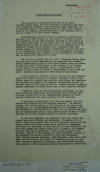
|
47.
January 10, 1933.
G-2 Translation of local press
on Sandino & Nicaragua, Capt.
Robert E. Cummings, Acting
Military Attaché, Mexico City,
p. 7:
"A Good Year for Nicaragua,"
El Nacional, Jan. 3, 1933,
p. 1.
" . . . Translation ¶ A GOOD
YEAR FOR NICARAGUA ¶ The
evacuation of Nicaraguan
territory by the North American
troops which, first for purposes
of protection and later for
introductory purposes, were
maintained there since 1926, is
an important event of the
present year, of (such) great
significance to all Spanish
American interests on our
Continent that we can not permit
it to pass without comment. ¶
Notwithstanding the fact that
our diplomatic relations with
Nicaragua have been severed for
some years as a result of these
same incidents, we now feel
ourselves entitled to
participate in the emotion which
must at this moment fill the
heart of the Nicaraguan nation
in order to celebrate with it
the liberation of its territory,
because we are certain that,
throughout this long painful
chapter of North American
intervention, we have been with
it in condemnation of the
weakness of its Governments, in
sorrow for its misfortunes and
in praise of the patriotism of
its rebels and the sacrificing
spirit of its sons. ¶ One can
not go deeply into the life of
Nicaragua during these last six
years without encountering the
repetition of an unfortunate
international policy of the
United States, which has served
to make that great Nation appear
as the scourge of the freedom of
the nations of the continent,
giving an opportunity to the
enemies of that nation to attack
it specifically in what they
consider a synthetic expression
of North American imperialism. ¶
A great spirit of hostility and
of aversion has been inspired
against the United States by its
rivals, creating a lack of
confidence among the Spanish
Americans who, even though not
experiencing directly the stroke
of the assault, nevertheless
noticed the constant threat to
the lives of all the Spanish
American republics, exposed
constantly to attack under more
or less disguised pretexts. ¶ A
veritable flood of
anti-imperialistic literature,
in many cases strong and
convincing, has cultivated that
sentiment that has done so much
harm to the understanding
between the North American
nation and the other countries
of the Continent. ¶ We
ourselves, incidentally, have
not been exempt from this
unfortunate situation for Pan
American interests. We believe,
however, that either because of
our location or our greater
accessibility, the understanding
between the two countries, with
the exception of the distant war
of 1847, has in general been
good, and the interruptions
which it has suffered have not
been of long duration and we
have quickly resumed our cordial
relations. ¶ In the other
Republics the situations that
have arisen have always been
more difficult and irritating.
To explain this it must be taken
into account that the North
American rulers have not always
solved with entire wisdom their
problems of expansion, with
which the capitalism of their
country is never satisfied, nor
have they always been strong
enough not to accede to the
demands of these insatiable
speculators. That is why,
because of the mercenary and
corrupt actions of their own
governments, small Central
American republics, like
Nicaragua, have had to fall
under the influence of this
class of “business men” who, to
give their actions a semblance
of legality, hide them behind
the general pretext of North
American interests threatened by
revolutions. . . . "
|
|
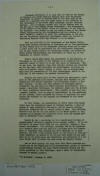
|
48.
January 10, 1933.
G-2 Translation of local press
on Sandino & Nicaragua, Capt.
Robert E. Cummings, Acting
Military Attaché, Mexico City,
p. 8:
"A Good Year for Nicaragua,"
El Nacional, Jan. 3, 1933,
p. 2.
" . . . Although officially it
is said that in view of the
Treaty of Tipitaca [Tipitapa]
the North American Marines have
left Nicaraguan territory, we
desire to believe that it has
been more on account of a
reaction that has taken place in
the criterion of the Government
of the White House regarding
Spanish American matters. And we
incline towards this belief
because none of the new men of
the United States Government –
the disapproval of the people of
the United States was apparent
at the time of the invasion –
has failed to see the moral
fiasco of the United States
represented by its intervention
in the affairs of a small
Republic, seeking to quiet the
restlessness of its people and
supporting unpopular governments
under the pretext of protecting
capital which was alleged to be
in danger. ¶ This new attitude
of the Government of the United
States, based upon genuine
principles of democracy and of
Pan-Americanism, is what should
give it the increased prestige
which can be such a great thing
and so beneficial for the
continental interests, and is
what should affirm its
civilizing action, its action
towards better understanding and
freindship [friendship] in every
one of the Republics of Spanish
origin. ¶ Doctor Sacasa can
assume the presidency of the
Republic of Nicaragua as the
result of his triumph in an
election the democratic purity
of which it is not out place to
challenge. But in any case, the
country, free from foreign
control and standing on its own
feet, will undertake the
development, spiritual as well
as material, which, sooner or
later, can be accomplished only
with the possession of its full
sovereignty, which is the only
way it can recover its genuine
nationality. ¶ Through the dense
mist of this latest and
unfortunate incident of Pan
American life shines, filling
that Republic to its boundaries
with heroic splendor, the
invincible figure of General
Sandino. In him, the free
opinion of Nicaragua upheld
throughout the six years of
North American intervention,
with a sacred, rebellious
obstinacy, the national ideal
and the justice of their
democratic convictions. That
handful of men that surrounded
Sandino, like an army of
condottieri, in the mountains of
his country, never measured the
danger of opposing its small
forces and elements of war
against the strength of the
North Americans. ¶ To this
figure, the romanticism of which
threw additional light upon the
democratic hopes of Spanish
America, a hymn of praise is
sung throughout the world, and
in America another similarly
clamorous one of racial pride in
sung. His attitude, whatever may
now be the new course of the
cause upheld by him, remains as
an example for those who still
love the sacred madness of
defending their country. ¶
Mexico was a spectator in this
complicated history of
international interests engaged
in an unequal combat. It is not
difficult to guess which side
had our sympathy, swayed by
fraternal sentiments. Our
attitude, however, had to be
abandoned in a certain point and
our official relations with the
Government of Nicaragua were
severed and have remained so to
date. However, now that a new
horizon opens to the future of
that glorious Republic, we
salute it in its new life which
we are sure will be to its brave
sons the foundation and
principle of a future vainly
held in check for some years by
foreign forces. ¶ And we also
express the hope that this North
American attitude may be the
beginning of an international
policy of effective
rapprochement between the great
North American nation and the
Latin republics of this
Continent, upon a basis of
cooperation founded on mutual
respect. ¶ “El Nacional”,
January 3, 1933. . . . "
|
|
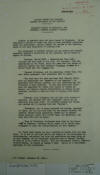
|
49.
January 10, 1933.
G-2 Translation of local press
on Sandino & Nicaragua, Capt.
Robert E. Cummings, Acting
Military Attaché, Mexico City,
p. 9:
"Sandino Fought and Defeated
General Colindres in the
Segovias — Colindres Wanted To
Proclaim a New Republic, Without
Sandino's Consent,"
La
Prensa, Dec. 29, 1932.
" . . . Translation ¶ SANDINO
FOUGHT AND DEFEATED GENERAL
COLINDRES IN THE SEGOVIAS ¶
COLINDRES WANTED TO PROCLAIM A
NEW REPUBLIC, WITHOUT SANDINO’S
CONSENT ¶ Sandino is becoming
more and more feared in
Nicaragua. He has converted a
handful of armed men into an
army perfectly organized, armed
and munitioned,- making himself
the master of Las Segovias,
where it has been impossible to
dislodge him. ¶ The newspapers
of Central America are now
giving out reports regarding
Sandino’s activities in Las
Segovias, one of which is copied
as follows: ¶ “Managua, Dec. 16,
1932. – Communicated from León.
¶ “Persons who have come to his
city, San Salvador, from the
Departments of the North, bring
the news that the forces of
Generals Sandino and Juan
Gregorio Colindres clashed in a
bitter fight and that Sandino
won. ¶ “General Colindres, and
the physician Arturo Vega, who
were taken prisoners, were
afterward shot to death. ¶ “For
some days the talk has been that
General Colindres had proclaimed
the ‘Republic of the Segovias’,
in agreement with General
Sandino, and that Colindres was
the President of that Republic.
It was also said that Colindres
had appointed Dr. Pedro José
Zepeda as Consul in Mexico, and
General Horacio Portocarrero as
Consul in San Salvador, neither
of whom had been in harmony with
Colindres. ¶ “However, this
procedure did not meet with
Sandino’s approval, who decided
that the ‘Republic’ should be
immediately done away with. He
therefore massed his troops and
started out to destroy that new
‘Cabinet’. ¶ “Colindres, who it
seems expected the attack,
prepared to fight, and one day
this week the two armies
clashed, Colindres’ forces being
completely routed and he himself
taken prisoner, along with
Arturo Vega, the physician, and
they were both shot to death. ¶
“Part of Colindres’ disbanded
army fled in the direction of
Honduras, reaching Danlí, where
it is stated they attempted to
join the revolutionaries of that
country.” ¶ Dr. Pedro José
Zepeda has been residing in
Mexico City for some tion
[time?]. He is one of the most
active and ardent of the
Nicaraguan revolutionaries, and,
during the time the revolution
has been going on in that
country, he has furnished
effective aid to General
Sandino, of whom he is an
intimate friend. When the
Nicaraguan General (Sandino)
visited Mexico, he stayed in
Zepeda’s home. Zepeda is a
well-known physician in this
metropolis. ¶ (“La Prensa”,
December 29, 1932.) . . . "
|
|
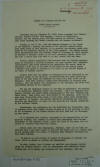
|
50.
January 10, 1933. G-2
Translation of local press on
Sandino & Nicaragua, Capt.
Robert E. Cummings, Acting
Military Attaché, Mexico City, p. 10:
"Return of a Mexican Officer Who
Served Under Sandino,"
El
Gráfico, Dec. 31, 1932, p.
1.
"Translation
¶ RETURN OF A MEXICAN OFFICER
WHO SERVED UNDER SANDINO ¶
Yesterday morning (December 30,
1932) there returned from
Central America, Captain 1st.
Cl. José Paredes, a native of
Guadalajara, Jalisco, who for
several years has been serving
in Sandino’s insurgent ranks
fighting the Yankee invasion and
the Moncada government. ¶
Paredes is one of the most
war-scarred veterans of the
“hosts of the Segovias”, bearing
the traces of the terrible
combats which have taken place
in that section, as he received
two serious wounds produced by
the explosive bullets of the
“blue-jackets”, the Yankee
marines which incorporated with
the National Guard of Nicaragua
to fight Sandino. He suffered a
horrible lesion in the left
pulmonary region, which left him
with a cavity like that made by
an axe, having lost one lung. ¶
Paredes returns completely
disillusioned with the Sandino
movement, which he considers a
military disaster, and only
regrets that “zánganos”
(adventurers) from other
countries are exploiting the
cause, which he considers a lost
one, at the cost of the lives of
the stupid people (“tontos”) who
insist on keeping up the fight
in the far-off region of the
heart of Central America. ¶
Paredes says that the people of
Nicaragua have not responded to
the desperate appeal of the
movement, notwithstanding the
great sacrifices which it has
cost those who embraced the
cause with such faith and
enthusiasm. Only when Sandino’s
forces were successful in
entering some village,- then the
people lent themselves to the
lootings, and after that
contributed nothing to the
campaign. ¶ The men who
accompany Sandino in the “war of
ambuscades” are natives of the
mountains, numbering about five
hundred. These are equipped with
regular armament and about
twenty machine-guns of the Keer,
Thompson and Lewis types. Many
rebels have been killed in the
campaign, which has become more
intensified since April of this
year, these being principally
the rustics, of farmers, who
served Sandino by furnishing him
with food supplies and
munitions, as these are the ones
who are cruelly sacrificed by
the National Guards. ¶
Furthermore, the enthusiasm for
the revolution has diminished,
upon it becoming known that
Sandino wished to keep on in his
attitude in spite of the
withdrawal of the Yankee marines
who have been held in Nicaragua
so many years. ¶ It is believed
that Sandino, convinced of the
impossibility of his military
triumph, will attempt to obtain
some advantages from the new
Government of the Republic,
which, after the first of the
year, will be headed by
President Juan Bautista Sacasa.
¶ Paredes comes now from
Tegucigalpa, Honduras, where he
has been recovering from a leg
wound which he received two
months ago in a combat when he
was serving under the orders of
Generals Juan Gregorio Colindres
and Juan Pablo Umanzor. ¶ He
says he is not willing to return
to Nicaragua to continue the
fight, which he claims is
sterile and unnecessary. ¶ He
adds, lastly, that division and
conflict have already started
among the Sandino leaders, with
the consequence that Colindres
fought Sandino and, as is known,
was defeated and fell prisoner,
then was . . . "
|
|
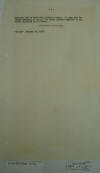
|
51.
January 10, 1933. G-2
Translation of local press on
Sandino & Nicaragua, Capt.
Robert E. Cummings, Acting
Military Attaché, Mexico City, p. 11:
"Return of a Mexican Officer Who
Served Under Sandino,"
El
Gráfico, Dec. 31, 1932, p.
2.
" . . . summarily shot to death
upon Sandino’s orders. It seems
that Colindres attempted to set
up “his little separate
republic” in the region
controlled by his forces. ¶
“Grafico”, December 31, 1932)"
|
|
|
United States National Archives, Record Group
165, Entry 77, Box 2653.
|

